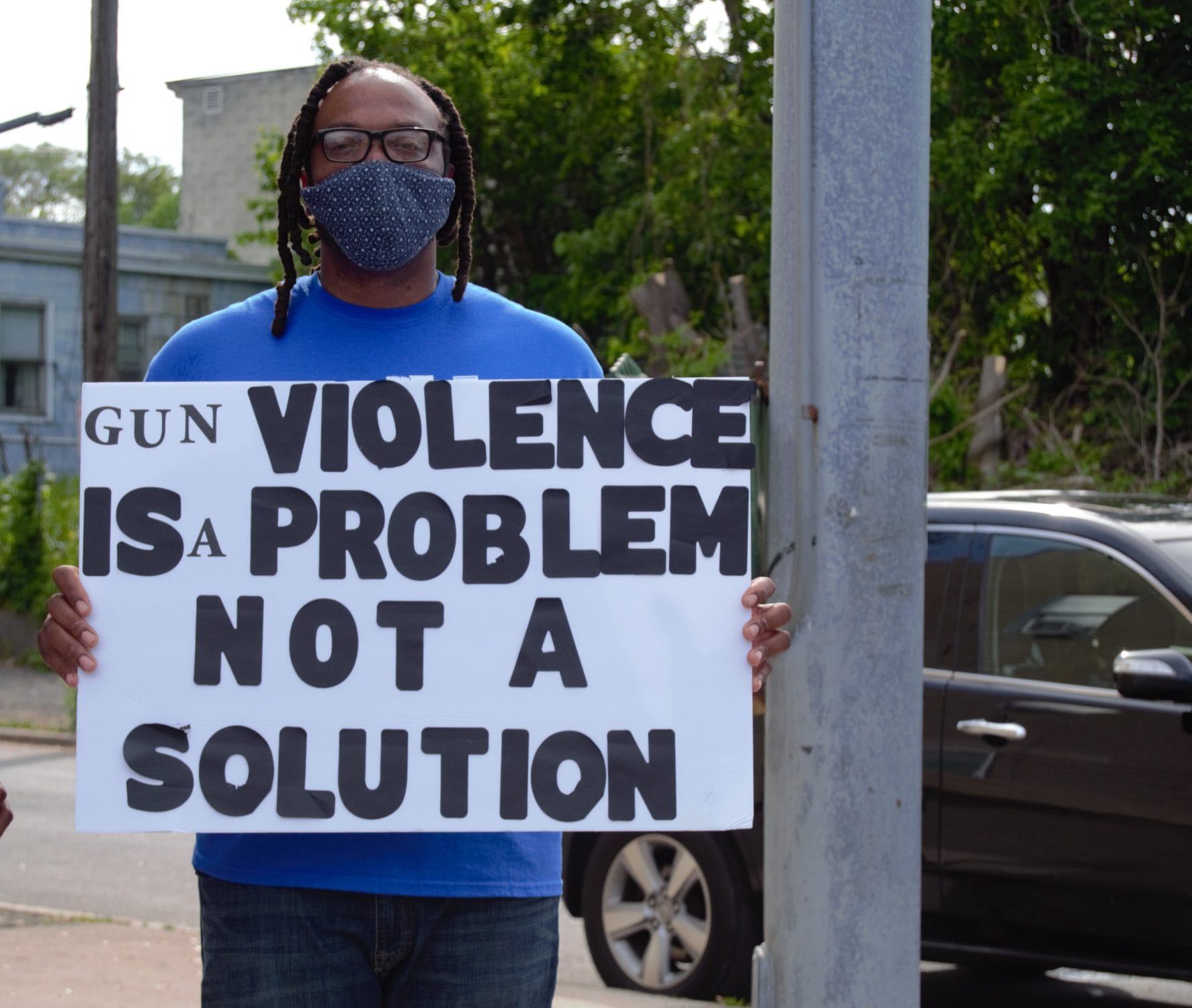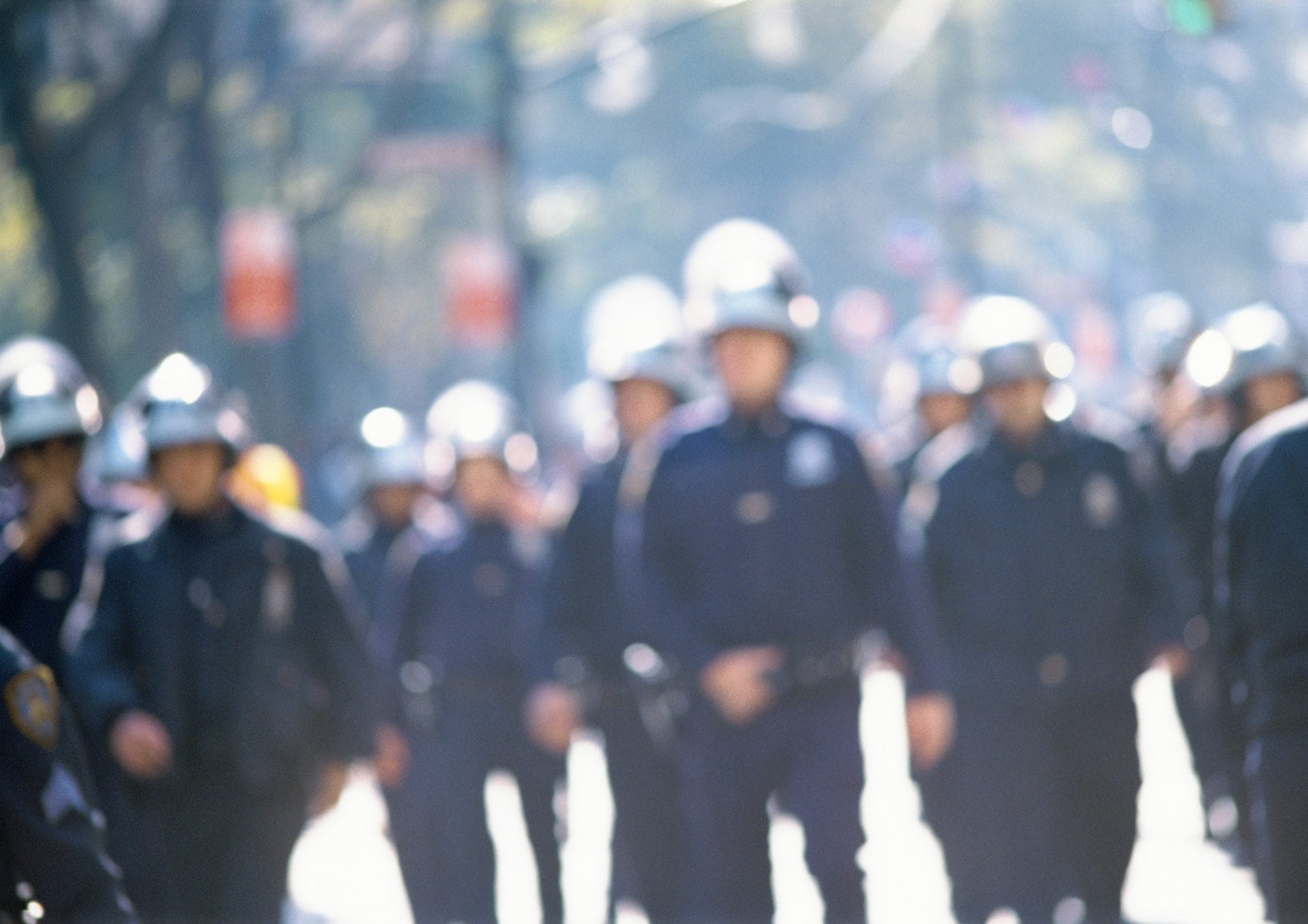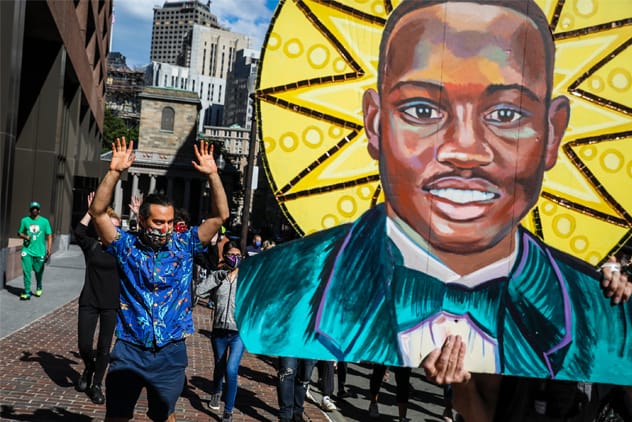
A Second Chance
The Case for Gun Diversion Programs
Introduction
Executive Summary
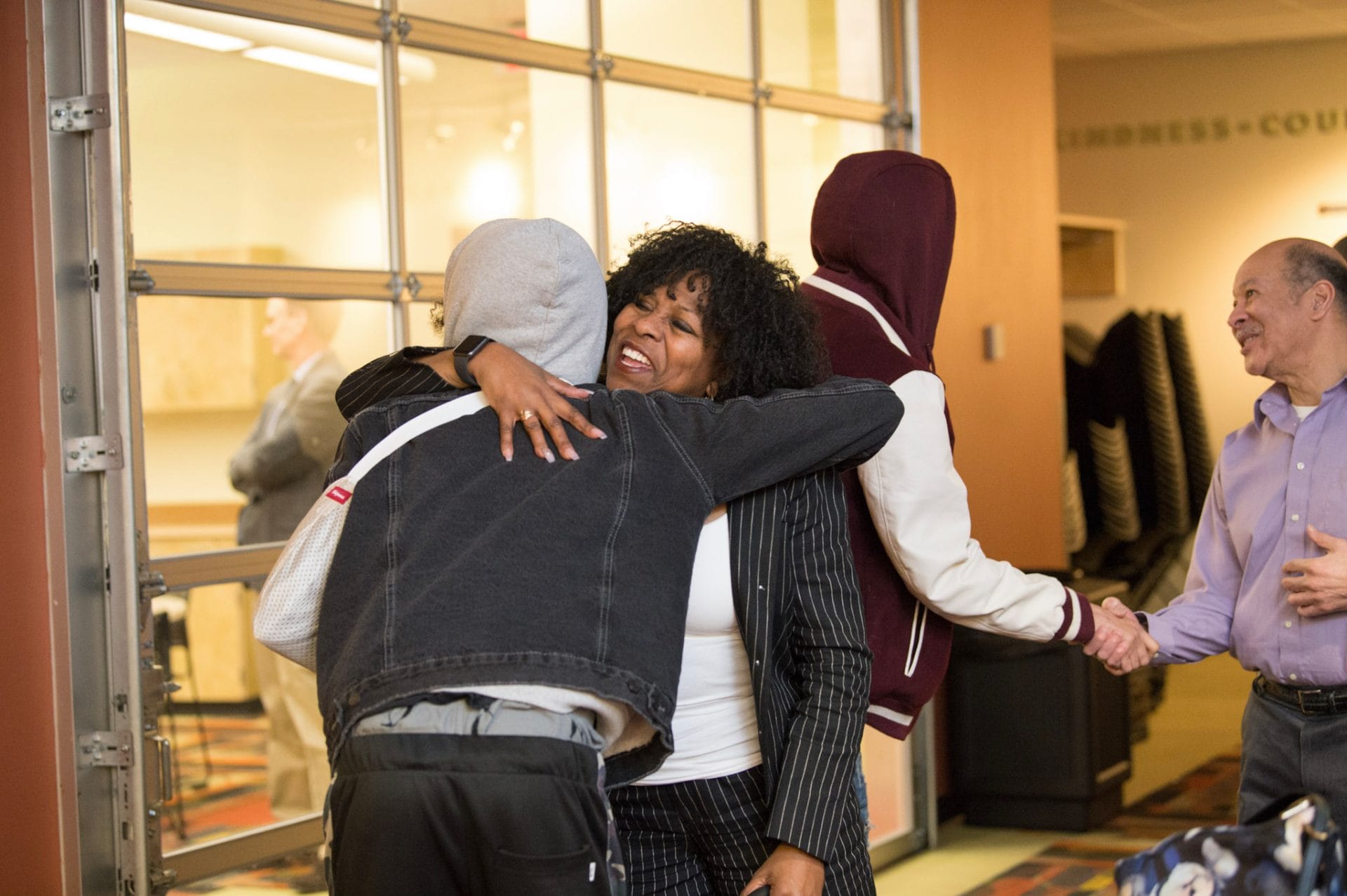
“I have the gun on me.”
“I’ll be a man about it.”
At Kevin’s pretrial hearing, officers on the scene recalled him saying these words the night he and his friends were arrested while in possession of an illegal gun in an apartment building in Brooklyn, New York.
The gun did not belong to Kevin. He didn’t live in the apartment where it was found. The police weren’t there to investigate him. But after trying and failing to hide the weapon from officers, Kevin decided he would take the fall.
The split-second decision nearly cost him his freedom. “To keep someone out of jail, I messed up my own life,” lamented Kevin in Emily Bazelon’s 2019 book Charged: The New Movement to Transform American Prosecution and End Mass Incarceration.1
Kevin had not hurt or tried to hurt anyone, but his charge—criminal possession of a weapon in the second degree (CPW2)—was considered a violent felony. In the state of New York, CPW2 carries a mandatory minimum sentence of three-and-a-half years, with a maximum of fifteen.2 That’s the same sentence a person would face if charged with the negligent homicide of a law enforcement officer.3
In jurisdictions across the country, a disproportionate number of young men of color like Kevin face lengthy prison sentences for nonviolent gun possession offenses. Given the very high conviction rates associated with such crimes, almost all of these young defendants will have their lives permanently altered by a devastating, sometimes false label given to them by the criminal legal system: violent felon.
The Kings County District Attorney’s office in Brooklyn is one of the few in the United States that offers an alternative path, a path that Kevin had the opportunity to pursue. Youth and Community in Partnership (YCP) is an alternative sentencing program offered by the district attorney that gives people charged with a first-time felony offense, including simple possession of a firearm, an opportunity to stay out of prison and have their conviction dismissed and sealed.4 The rigorous program includes a nightly curfew, random drug tests, unannounced home visits by police, and weekly trips to the district attorney’s office to see a YCP social worker.5
Though YCP is strict, the consequences are far less disruptive than those of a violent felony conviction. In addition to a prison sentence, subject to mandatory minimums, people convicted of felonies face stigma and systemic barriers that make it more difficult to access rights and benefits like employment, higher education, voting, vocational certification, and housing.6 When a felony is classified by the law as “violent,” those collateral consequences are even more severe.
As a YCP participant, Kevin faced numerous challenges. An arrest for loitering and a lab error resulting in a positive drug test nearly prompted his expulsion from the program, but Kevin persevered. After one year, he successfully completed YCP.
“You and you alone made the choice to finish,” Kevin’s lawyer reminded him ahead of his final court date, “and when you set your mind to it, you did. I hope that also shows you, Kevin, that you are someone who, when you set your mind to something, you’re able to achieve and do it.”7
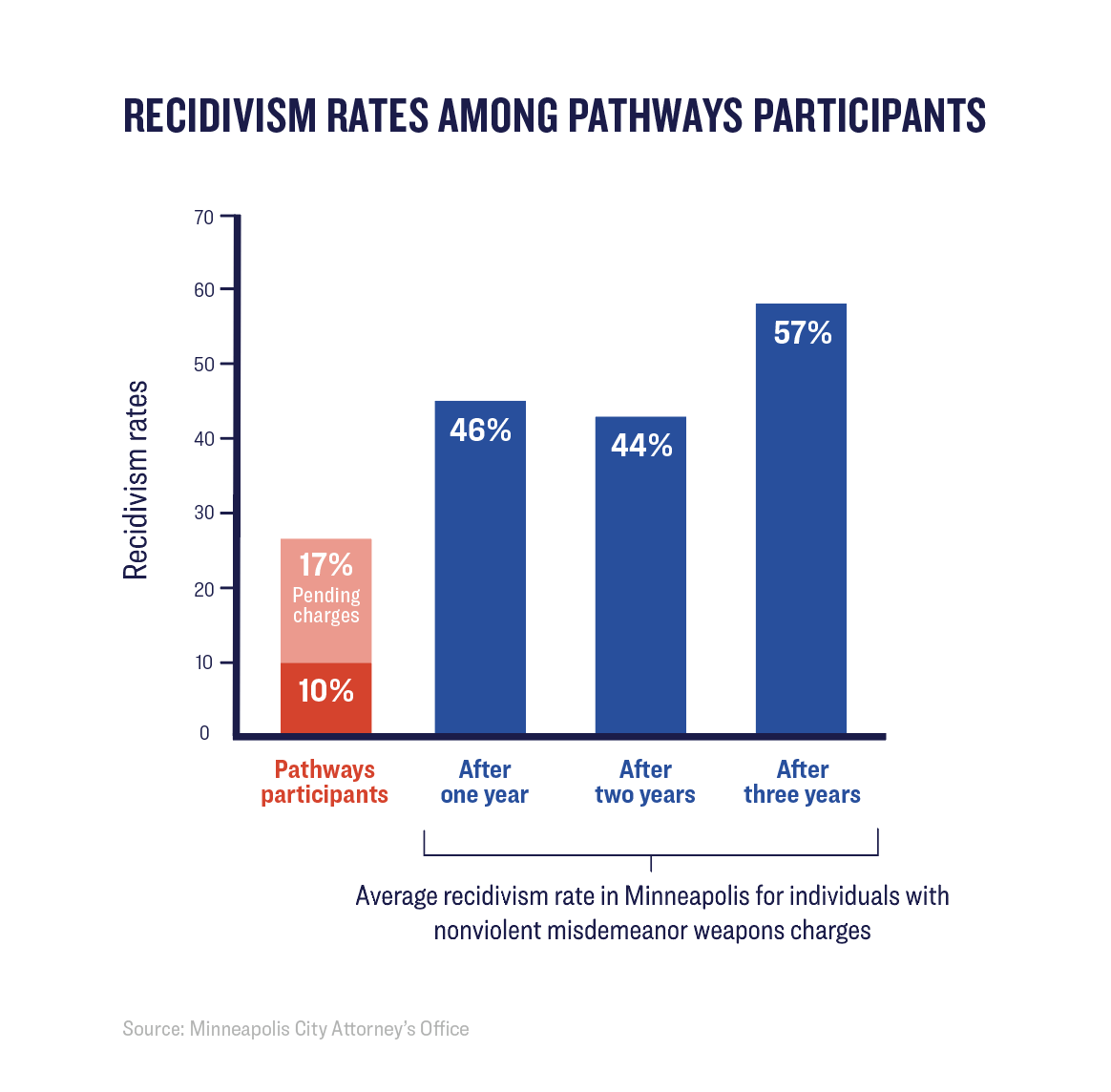
Diversion programs are more common for people accused of drug possession, and there exist only a handful of programs like YCP that offer alternatives to incarceration for people accused of illegal gun possession. Early data on such programs suggest that diversion may significantly reduce recidivism and, in turn, enhance public safety while reducing the staggering costs of the criminal justice system.
In Brooklyn, the hundreds of young people who have completed YCP in recent years had a 22% lower rearrest rate within three years than others in their 16-to-24-year-old age group who went to prison and then were released.8 As District Attorney Eric Gonzalez—who was appointed district attorney in 2016 and then elected to office in 2017—embraced expanded diversion and other reforms intended to improve public safety while also reducing incarceration rates, homicides in Brooklyn fell to record-setting lows for three consecutive years. At the same time, overall arrests dropped by a third: from 87,607 in 2016 to 58,288 in 2019.9
Another one of the very few other jurisdictions in the US to offer diversion directly to those with firearm-related charges is Minneapolis, Minnesota, where the murder of George Floyd rocked the country and catalyzed a worldwide social justice movement in 2020.10 Its Pathways to New Beginnings program originated in 2017, when staff at the Minneapolis City Attorney’s Office looked closely at the numbers and found that gun possession charges were almost exclusively enforced against young men of color and were leading to more crime, not less.11 “It was clear that conviction was not putting them on a good path or improving public safety in any meaningful way,” said Deputy City Attorney Mary Ellen Heng.
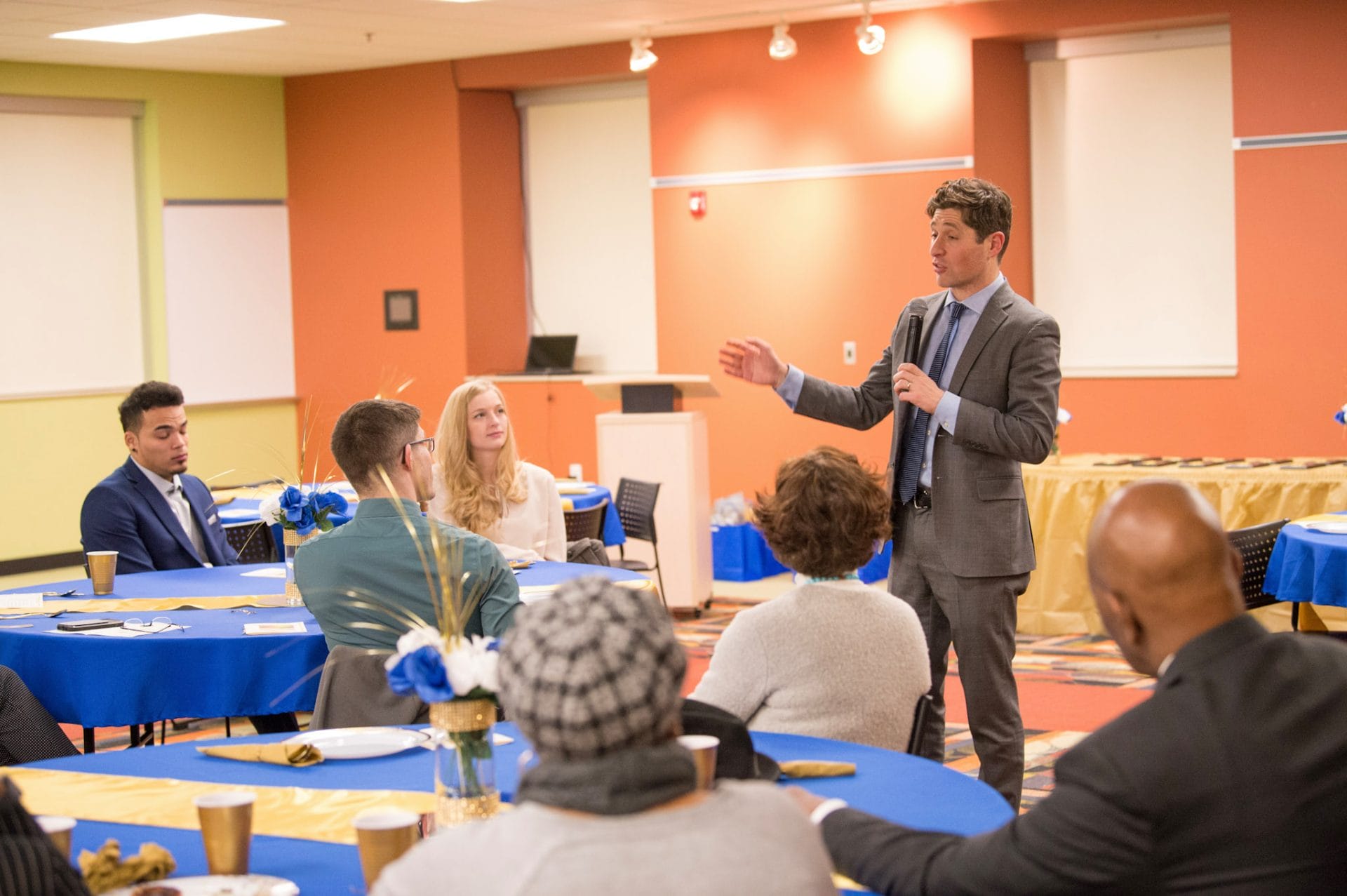
Photo taken at Pathways to New Beginnings graduation ceremony, courtesy of Urban Ventures.
The Pathways to New Beginnings program, designed in partnership with Urban Ventures, a community-based organization in Minneapolis, requires those with nonviolent firearm-related charges to participate in a nine-month process that includes case management and group coursework that focuses on participating in cognitive behavioral therapy, addressing trauma, and building life skills.12
While the program is still relatively young, early data indicates that graduates of the program have lower recidivism rates compared to individuals who are convicted and given a traditional jail sentence. This is in line with the existing literature, which suggests that prosecutor-led13 diversion programs for certain charges or case types, such as drug-related offenses, can have moderate to large impacts on recidivism rates.14
Programs like Pathways and YCP are proof that another way is possible: society can better protect public safety without resorting to automatic and draconian punishment for every single person caught with an illegal gun, a policy that essentially criminalizes the fear and trauma that too often lead some young men of color to pick up a gun in the first place.
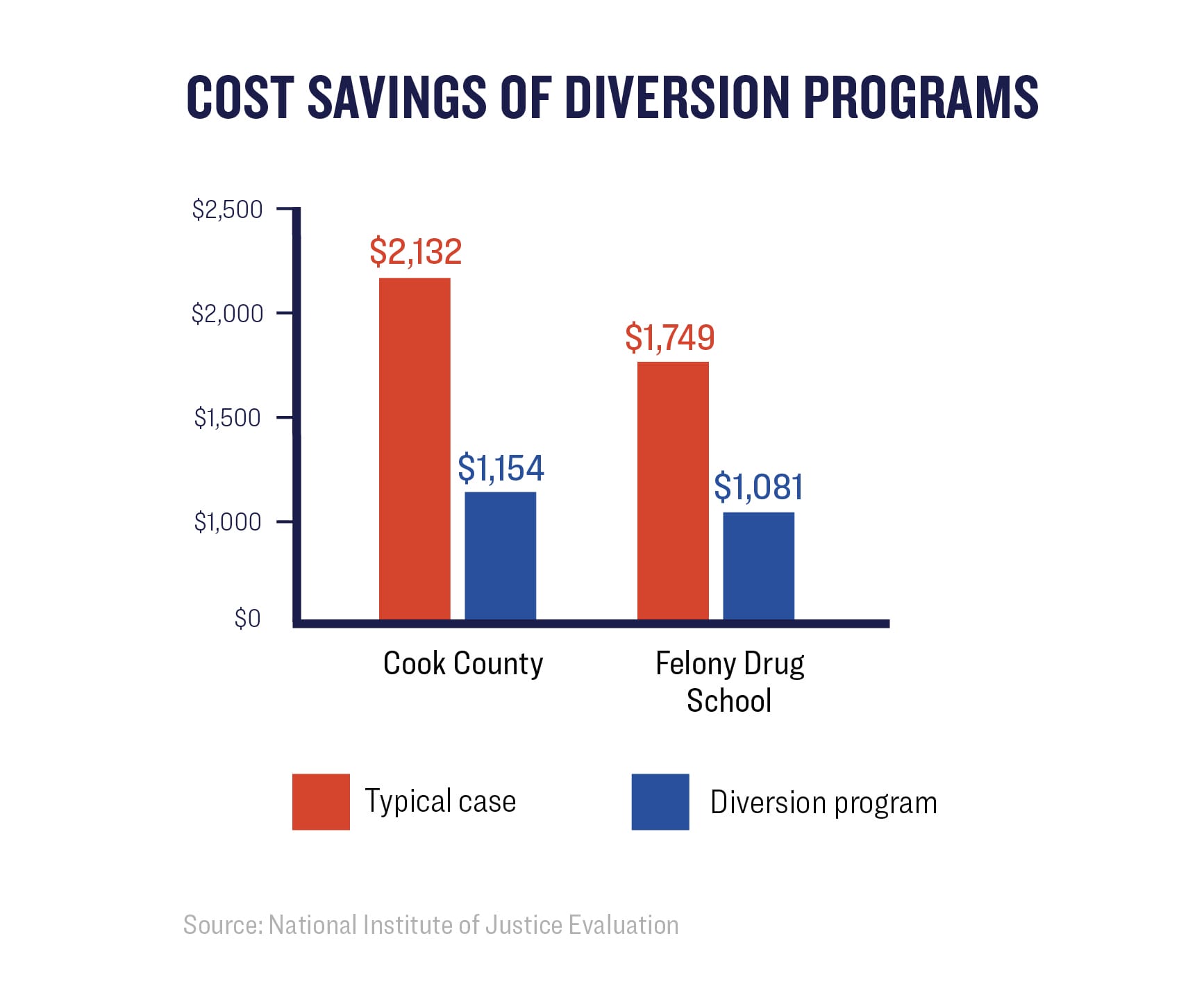
A 2018 study of prosecutor-led diversion programs funded by the National Institute of Justice included impact evaluations from five alternative sentencing programs. Participants in all five programs were less likely to be convicted and incarcerated, and in four of the five programs, participants had reduced rates of recidivism.15 These programs also have a track record of “off-ramping” cases early in the court process, reducing court backlogs and generating cost savings, with researchers finding that four of the five evaluated programs generated “sizable cost and resource savings.”16
While elected prosecutors have traditionally been reluctant to offer alternatives to incarceration for illegal gun possession,17 diversion programs in this context have the potential to intervene at a pivotal moment to offer people the tools and support they need to significantly reduce their risk of recidivating, simultaneously improving public safety and outcomes for individuals.
Based on the evidence in support of diversion programs in general, and the positive early experiences in places like Brooklyn and Minneapolis, Giffords recommends that prosecutors around the country implement diversion programs, including for certain individuals facing nonviolent firearm-related charges. Prosecutors are uniquely positioned to do this because of the large discretion generally given to them in making charging decisions.18 Since local prosecutors are usually elected officials, activists and advocates can also support the expansion of diversion programs by building relationships with local prosecutors and participating in prosecutorial elections.
There is also an important role for legislators to play here: local, state, and federal leaders should provide funding to incentivize jurisdictions to pilot and expand diversion programs. In addition, legislators should consider reforming both overly punitive sentence enhancements for nonviolent gun offenses, and also laws that classify nonviolent acts as violent felonies.
A Second Chance: The Case for Gun Diversion Programs looks at how prosecutor-led diversion programs can reduce recidivism and enhance public safety, while also helping to address mass incarceration. This report includes concrete recommendations for prosecutors and lawmakers to help bring prosecutor-led diversion to scale, and improve our criminal legal system’s response to illegal gun possession.
Kevin deserved a second chance. He ultimately got one, but in too many parts of the country, alternatives to incarceration simply don’t exist. This needs to change.
MEDIA REQUESTS
Our experts can speak to the full spectrum of gun violence prevention issues. Have a question? Email us at media@giffords.org.
Contact
The Need for a New Approach
Strengthening America’s gun laws is one important way to save lives from the ongoing gun violence epidemic, but we must be clear-eyed about how gun laws are being enforced, with an understanding of the pervasive structural racism and implicit biases that are baked into the criminal legal system. The notion that simply increasing the number of convictions for illegal gun possession in high-crime areas will improve public safety has led to local and national policy decisions that have disproportionately impacted the lives of people of color and Black men in particular.
Given the reality that the majority of violent crime in any given city is committed by a very small percentage of high-risk individuals, a more strategic approach to gun-related cases is needed, one that includes as many off ramps as possible for individuals who do not actually pose a threat to their communities. This is not to say that law enforcement should stop enforcing gun possession laws. Rather, law enforcement should focus their resources and efforts on actual acts of violence—homicides and shootings—while simultaneously narrowing the circumstances in which incarceration is the default response to illegal gun possession.
The prison population in the United States—a staggering 1.8 million people—is by far the largest in the world.19 According to a 2014 study by the National Research Council, American prisons hold around one-fourth of the world’s prisoners.20
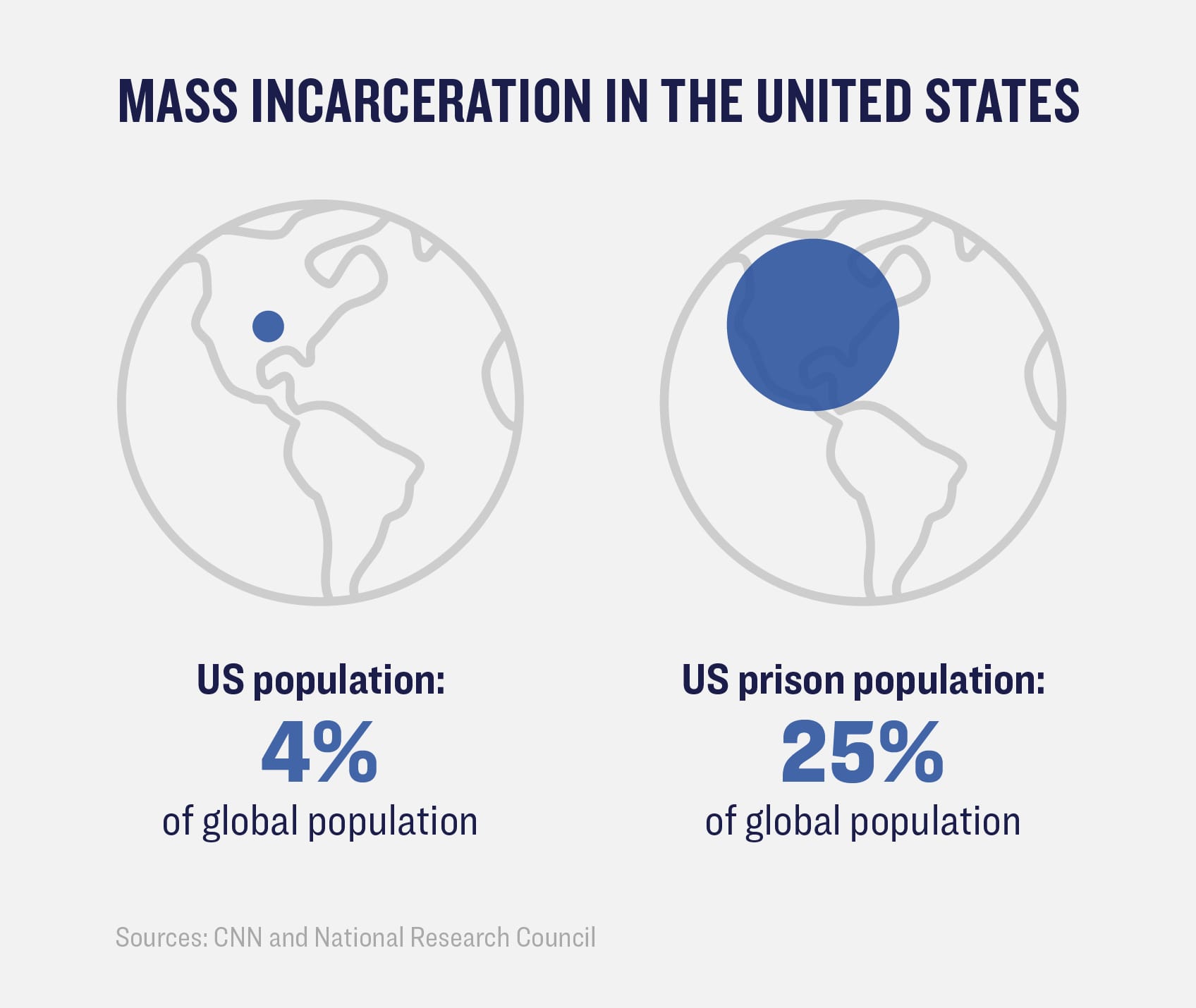
Though the war on drugs bears much of the responsibility for mass incarceration and the country’s bloated prison population, which has increased by 700% since the 1970s,21 a movement toward harsher punishments for illegal gun possession has also contributed to more convictions and longer sentences for many people who have not committed an act of violence.22
Sentences for gun-related offenses are more often for possession than actual acts of violence. According to the US Sentencing Commission, only 6.8% of federal firearms cases involved the use of a firearm in the commission of a violent or drug trafficking crime, while two-thirds (66.3%) involved illegal possession of a firearm, usually by someone who had been convicted of a prior felony.23
Moreover, gun-related sentences affect a larger segment of the justice system than one might think. Nationally, more than 150,000 individuals were arrested for weapons-related possession and carrying offenses in 2019,24 and more than 14,000 individuals were charged with firearm-related offenses in federal fiscal year 2020.25
As of 2019, nearly 40,000 inmates in the custody of the California Department of Corrections and Rehabilitation had some form of firearm-related enhancement as part of their sentence.26 That’s 40% of California’s entire incarcerated population—and more than 80% are Black or Latino.27 It’s worth noting that these enhancements can apply even if the firearm in question was unloaded or otherwise inoperable.28
Relying so heavily on incarceration can actually worsen public safety by exacerbating the conditions that drive violence, such as poverty, poor access to education, untreated trauma, and a lack of affordable housing.29 As a report from the Vera Institute of Justice notes, incarceration is “neither the most effective way to change people nor the most effective way to keep people safe.”30 According to the National Academy of Sciences, “most studies estimate the crime-reducing effect of incarceration to be small and some report that the size of the effect diminishes with the scale of incarceration.”31
There is strong evidence that incarceration is criminogenic, meaning that people exiting prison are actually more likely to reoffend because of the effects of prison.32 Improved public safety is the assumed goal of the criminal legal system, yet mounting evidence shows that blunt “tough on crime” policies are simply not achieving that result.
Recent research from a team of criminologists at Loyola University of Chicago found that almost two-thirds of convictions involving a firearm in the state of Illinois over the past decade were for the nonviolent possession of a gun, with disproportionate convictions of Black men.33 Yet despite Illinois’s emphasis on prosecuting illegal gun possession and increasingly harsh punishments—prison admissions for gun possession offenses increased 27% between 2014 and 2019, while admissions for all other crimes fell 38%34—gun homicides in the state increased nearly 29% from 2014 to 2019.35
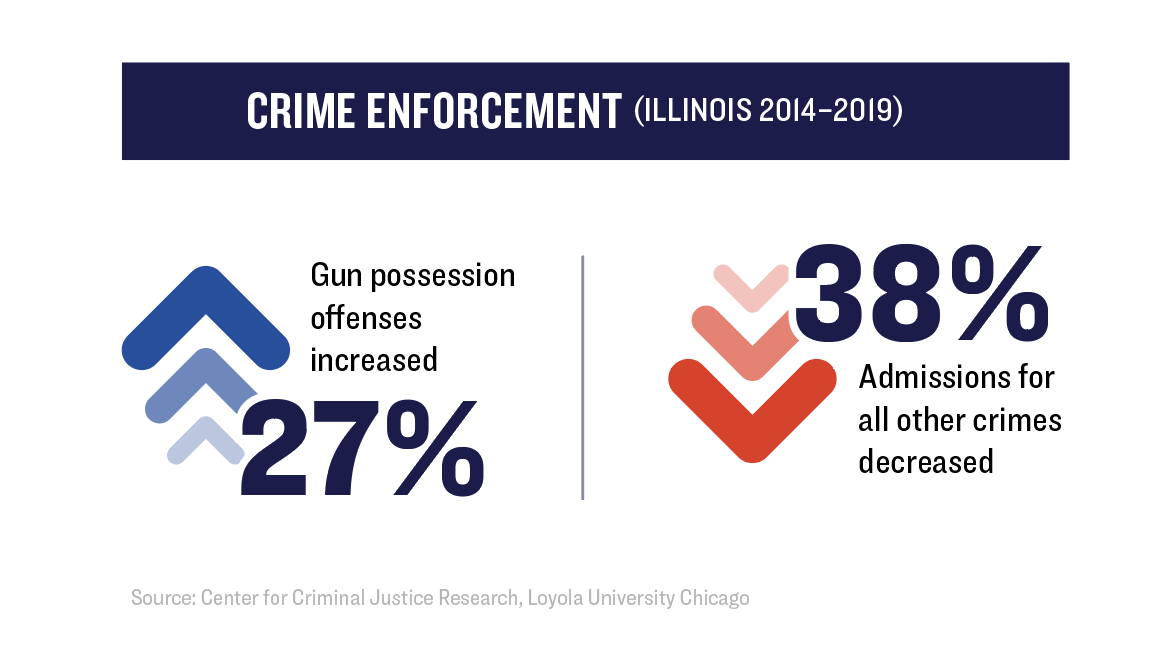
This is consistent with data from Chicago that, as a spokesman for State Attorney Kim Foxx’s office noted, “doesn’t show that the drivers of the violence are the people who’ve been arrested for nonviolent gun offenses.”36 It stands to reason that if only a small subset of individuals are responsible for the majority of violence in a given city,37 then prosecuting as many people as possible for illegal gun possession—and applying the most severe sentence possible—is unlikely to yield major public safety benefits.
Unfortunately, policy in Illinois, New York, and other states does not reflect this. In Illinois, the charge of “felon in possession” of a firearm (a Class 3 felony), which does not require any evidence that the defendant acted violently or had intent to act violently, carries a mandatory prison sentence of two to 10 years.38
Meanwhile, actual acts of violence often go unaddressed by the criminal legal system. While the national homicide clearance rate—the number of cases in which an arrest is made—is around 54%,39 in 2019 the homicide clearance rate in Chicago was just 33% for Latino victims, and only 22% for Black victims.40 Nationally, across 52 of the largest cities, nearly three-quarters of all unsolved murders involved a victim who was Black.41 The clearance numbers for nonfatal shootings are even lower, a failure that fuels retaliation, erodes public trust in law enforcement, and creates an environment of fear in which the decision to carry a gun, even illegally, seems rational.
At the national level, focusing on gun possession rather than actual acts of violence has been the primary strategy to address gun violence for nearly two decades. Project Safe Neighborhoods (PSN), the country’s only federal grant program created to directly address shootings and gun homicides, was launched in 2001 by the Bush administration. PSN began with a $200 million investment to streamline convictions for gun possession.
America at a Crossroads: Reimagining Federal Funding to End Community Violence
Brittany Nieto, Mike McLively—Dec 17, 2020
PSN dramatically increased the number of federal prosecutions for the illegal possession of a firearm—but without any corresponding public safety benefit. Five years after PSN was launched in 2001, federal prosecutions for illegal gun possession more than doubled, reaching a peak of more than 10,000 in 2006.42 However, as noted in the 2020 Giffords report America at a Crossroads: Reimagining Federal Funding to End Community Violence, this surge in prosecutions was not accompanied by a decline in the national homicide rate. In fact, the homicide rate five years later was higher than it was at the start of PSN.43
PSN has remained in place, although the program has shrunk substantially since its launch. After almost two decades, US gun homicide rates in 2019 were higher than they were in 2001, when PSN was first introduced. This is a far cry from success. Moreover, the punitive approach of PSN has taken a disproportionate toll on Black Americans, who in 2019 accounted for more than half of all federal felon-in-possession convictions, while making up less than 15% of the total US population.44
Though the Biden administration has issued new guidance that could help strategically redirect PSN,45 the program as implemented has led to increased prosecutions, convictions, and incarceration, disrupting countless lives with little to no benefit to public safety to show for it. It’s time to embrace a different approach.
POLICE VIOLENCE IS GUN VIOLENCE
We’ve signed on to a letter from the Community Justice Action Fund to demand accountability and stand in support of anti-racist action.
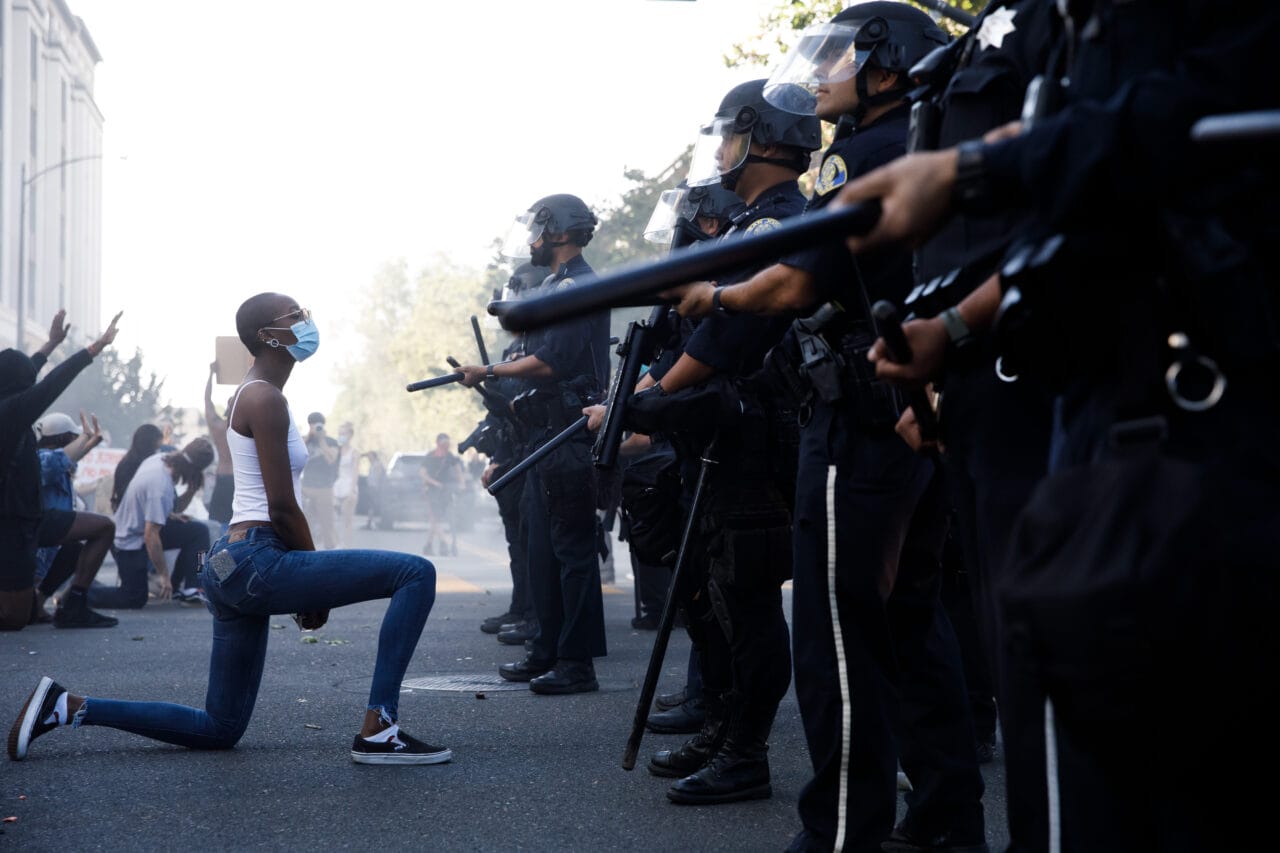
Prosecutor-led Diversion
The term “diversion” refers to a variety of strategies that provide people on a path to incarceration with opportunities to exit the criminal legal system or avoid it entirely. This can include community-based services provided before an encounter with law enforcement (“pre-police diversion”), judiciary-led diversion like community and problem-solving/collaborative courts, and police-led diversion programs that empower officers to impose lighter sanctions on individuals who would have otherwise been placed under arrest.46
Prosecutor-led diversion programs, the focus of this report, can be offered before or after charges are filed; address a range of crimes, including misdemeanors and felonies; and have varying service and treatment requirements.47
The Power of Prosecutors
The American legal system generally places very few constraints on prosecutors.48 Although judges and juries can provide some formal institutional check on the power of prosecutors, the reality is that such checks are highly limited in a criminal legal system where more than 96% of felony convictions are settled out of court—without a jury. In the plea bargain process, defendants are incentivized to forfeit their right to a jury trial with the threat of long mandatory prison sentences if they contest the charges and are ultimately found guilty at trial.
With an absence of formal legal controls on the power of prosecutors, the US relies on voters to serve as a check through regular elections. “The American solution to the weak institutional controls on prosecutors comes from the ballot box,” wrote law professor Ronald Wright in 2014.49 In fact, the US is one of the only countries in the world where citizens have the power to elect prosecutors.
As Emily Bazelon argued in Charged, the unfettered power of prosecutors is “the missing piece” for explaining the explosive and devastating growth of mass incarceration in the United States and its disproportionate impact on communities of color. Prosecutors are the key to changing the criminal legal system and reducing America’s harmful over-reliance on incarceration, which means that ultimately, the power to choose a different approach lies in the hands of the American people.
However, this power of choice is not one that voters have historically been able to exercise in practice: a 2015 report from the Reflective Democracy Campaign found that, of the more than 2,400 elected local prosecutors around the country, a large majority of incumbent prosecutors (85%) simply ran unopposed.50 This leaves incumbent prosecutors less accountable to a competitive election process. Low turnover has also maintained the lack of representation of communities of color among prosecutors: the same 2015 report found that 95% of the country’s elected prosecutors were white and 83% were men. Only one percent were women of color.51
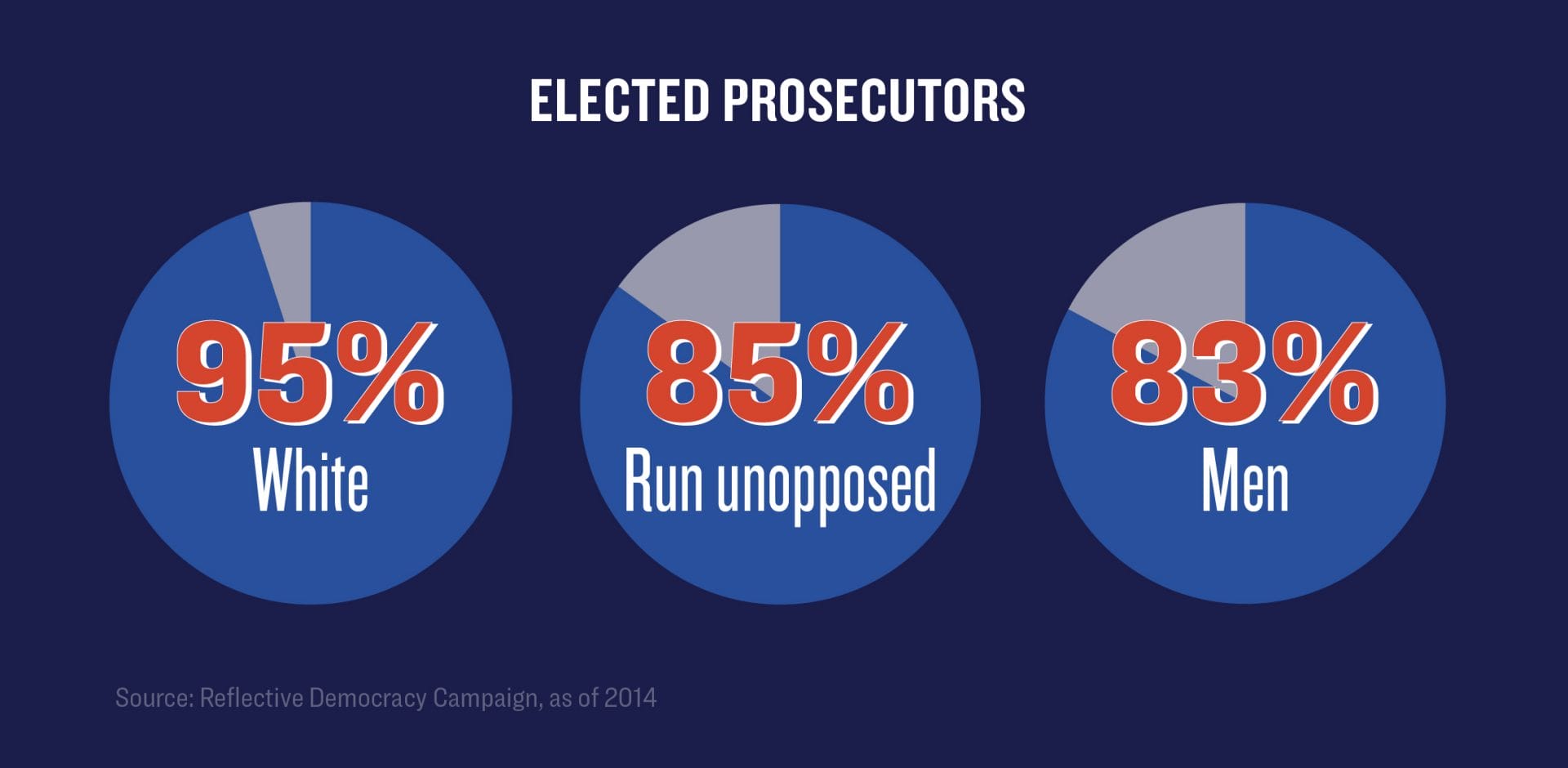
Since the power of prosecutors to shape the criminal legal system is not widely understood, local prosecutorial elections have largely flown under the radar of the general public. As Kansas City District Attorney Mark Dupree, the first Black man to be elected district attorney in the state, described: “Before I ran, maybe 15 to 20 percent of the community knew what the D.A. does. Everyone got mad at the police but didn’t know anything about the office behind it.”52
The social justice organization Color of Change maintains a first-of-its-kind national directory of local prosecutors, where voters can easily find out who their lead local prosecutor is, how long they’ve been in office, and when they are next up for re-election. Additionally, Fair and Just Prosecution—in partnership with Yale Law School, the Justice Collaborative, and Brennan Center for Justice—created 21 Principles for the 21st Century Prosecutor, which advocates can use to evaluate their local prosecutors. The very first recommendation of the report is for prosecutors to make diversion the rule, rather than the exception.
The History of Diversion Programs
Diversion programs have been a part of the country’s criminal legal system for decades. After gaining traction in the 1970s, they have since been replicated in every state in the nation, in both rural and urban areas alike.53
Though today a growing body of research supports diversion, early programs did not demonstrate a positive impact on outcomes or cost savings, due in part to their sole focus on extremely low-level offenses.54 Cases routed to diversion were often so minor that they were unlikely to create adverse consequences for those charged, resulting in “net widening,” or the creation of new treatment and service requirements that were both ineffective and more burdensome than the consequences defendants otherwise faced.55 Researchers also note that early programs tended to use a “one-size-fits-all” approach to treatment that was supplied by in-house staff and did not always relate to the offense.56
Diversion has evolved considerably in recent years and is now available for much broader charge types. According to a survey published in 2019 of more than 200 prosecutors’ offices, 55% of offices surveyed offered some form of diversion programming.57 Where diversion was available, 60% of offices considered nonviolent misdemeanor charges and 56% accepted people accused of certain non-violent felonies.58
While some are hesitant to expand diversion programming to felonies and more serious charges, evidence suggests this shift can achieve greater outcomes and cost savings while minimizing the risk of net widening. For example, an evaluation of a Drug School program in Cook County, Illinois, that has separate tracks for individuals accused of misdemeanor and felony drug charges, found that only one percent of those enrolled in felony Drug School received a jail sentence, compared to 37% of those who did not opt for diversion.
Participants also had a significantly lower conviction rate (three percent) compared to 63% for the comparison group. Moreover, two years later, when most rearrest and recidivism occurs,59 felony Drug School participants continued to experience a rate of rearrest that was 11% lower than the comparison group—a statistically significant reduction.60 The felony program alone is also estimated to save over $2,200 per case, a figure that does not include cost savings resulting from reduced recidivism and rearrest.
While misdemeanor Drug School showed positive results as well, the same evaluation warned that the program may be contributing to the problem of net widening. Though no participants in the misdemeanor diversion program received a jail sentence, comparable misdemeanor defendants were also very unlikely to receive jail time (three percent). To avoid net widening and achieve greater outcomes for individuals, findings in Cook County and elsewhere61 suggest that diversion programs may benefit from considering more serious offenses, including those involving illegal gun possession.
A far cry from the “one-size-fits-all” approach of the 1970s, nearly 70% of programs use an assessment tool to screen participants and determine the content and length of mandated services.62 The most common program requirements include community service, substance abuse education and treatment, and individual therapy.63 Programs achieving the most success have implemented evidence-based service and treatment requirements that relate directly to the crime, and treat the underlying conditions and risk factors that led to the offense.64
Diversion may be pre-filing, in which prosecutors refrain from filing charges so long as the defendant successfully completes the program, or post-filing, which is often used with higher-risk cases65 and takes place after charges are formally filed.66 In post-filing programs, prosecutors suspend the sentencing process while the defendant completes the program.
Participants who do not complete the program are routed back to the traditional legal system, where survey results indicate they are most likely to face conviction with a sentence of either probation or jail time.67
Successful completion of a diversion program, however, generally results in charges being dismissed and/or expunged, or in the case of pre-filing programs, no charges are filed at all. Only six percent of programs reported closing the case with no dismissal of charges upon successful completion.68
In 2018, the National Institute of Justice published an analysis of prosecutor-led diversion programs, which included impact evaluations from five diversion programs and a related cost analysis from four different programs.69 Researchers compared diversion participants with a matched comparison group of defendants who did not participate in diversion and found that all five programs saw lower conviction rates among participants.70
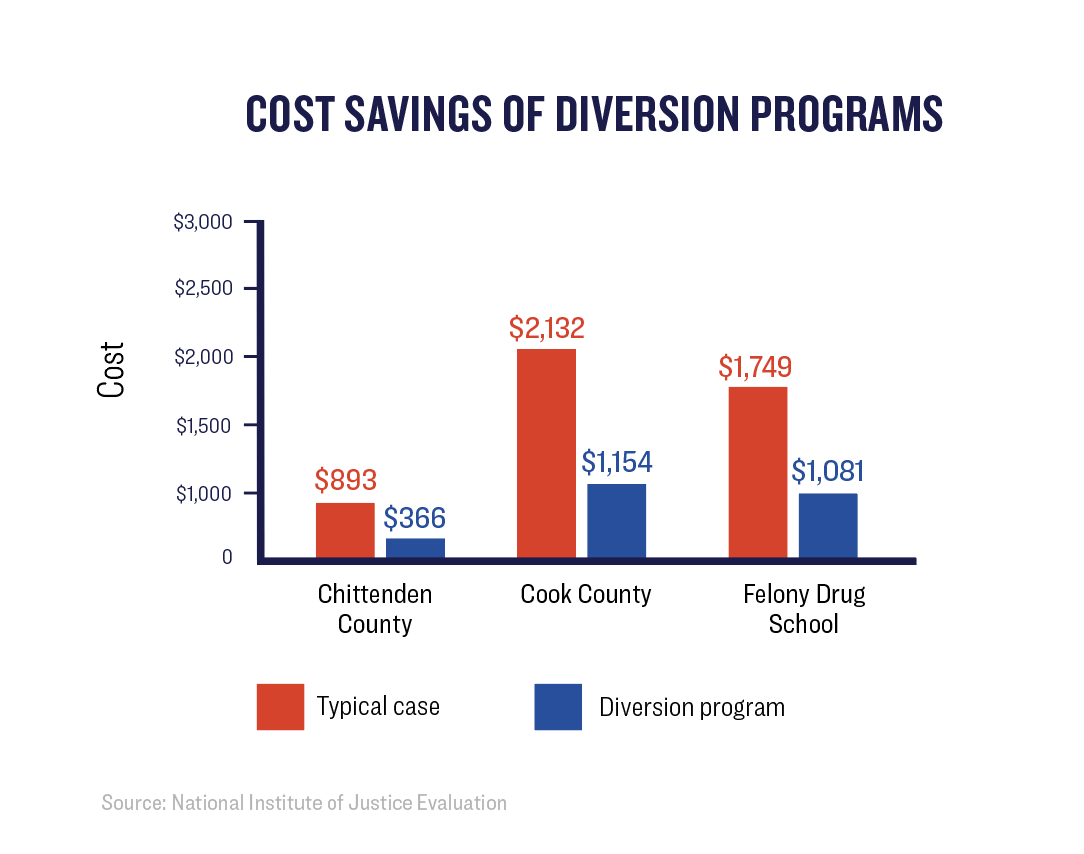
Moreover, in four of the five programs, participation led to “meaningful recidivism reductions,” including a reduced rate of rearrest over a two-year period.71 Additionally, all four programs for which a cost analysis was conducted demonstrated significant cost savings, with pre-filing programs producing the most substantial savings due to the early stage at which they interrupt the prosecution process.72
Minneapolis Case Study
In Minneapolis, Minnesota, Deputy City Attorney Mary Ellen Heng oversees a team of prosecutors handling all gross misdemeanor gun cases,73 including charges like carrying a pistol without a permit.
In 2016, one of Heng’s prosecutors approached her with a troubling observation: almost every gross misdemeanor gun case brought by their office involved a young Black man.74 Concerned by this, Heng decided to conduct a thorough investigation. What she found was eye-opening.
Heng and her team found that of those convicted of a weapons-related gross misdemeanor between 2014 and 2016, 88% were non-white, despite the fact that people of color represented 37% of the overall population in Minneapolis.75 Moreover, the large majority of those charged with non-violent illegal gun possession offenses were Black and between the ages of 18 and 35, while 75% of total convictions were of Black men and youth.76
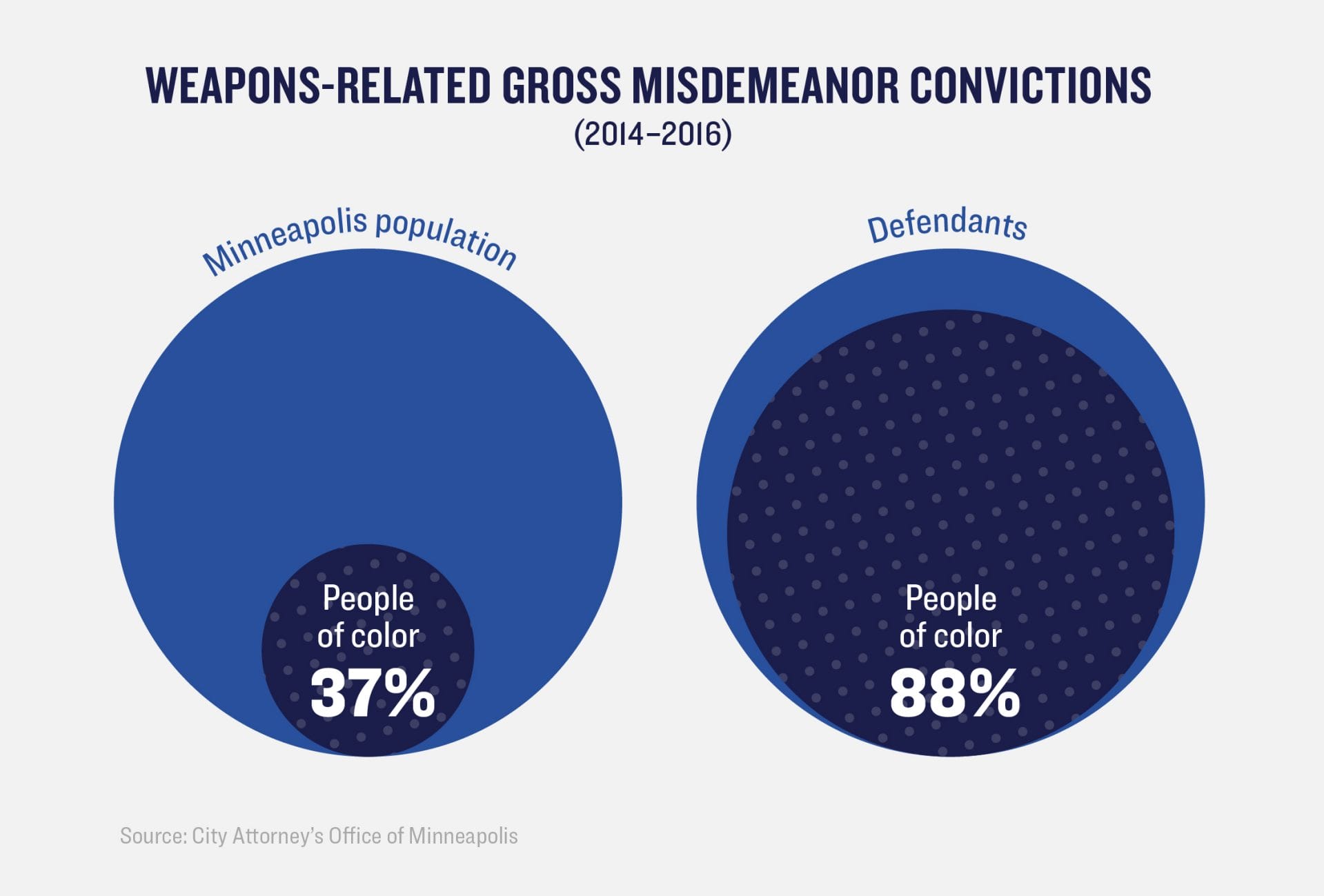
This racial disparity was extremely alarming, especially given that Black males made up less than six percent of the overall Hennepin County population.77 An even bigger shock came when Heng and her team looked into recidivism rates for those convicted of nonviolent gun charges, which typically carry a 30-day jail sentence.
“What I found was appalling,” Heng recalled. “Our review of years of data showed that around 70% of those convicted of gross misdemeanor weapons charges went on to commit another offense within three years—with long prison sentences for many young defendants under the age of 30, even for non-violent offenses.”
Although Heng’s team was getting conviction rates as high as 90% for illegal possession of weapons charges, “we saw that we were doing almost nothing to change the trajectory of these individuals’ lives.”78 The undeniable conclusion was that the 30-day sentence and subsequent probation simply wasn’t enhancing public safety, and certainly wasn’t leading to better outcomes for the individuals convicted of these nonviolent offenses.
Heng and her team asked themselves what they could do differently to change the patterns they were seeing. Almost across the board, young defendants of color said they were carrying firearms in the first place to protect themselves. As a starting point, Heng wanted to better understand the root causes of that behavior.
One of the first things her office did was to reach out to a long-time community worker in Minneapolis who had lived experience with the criminal justice system. “This was the first time anyone had talked to me about trauma and its role in the decision to carry a firearm,” said Heng. “Once we understood that there’s unaddressed trauma behind the decision to carry a gun, we realized we needed a trauma-informed approach as an alternative to incarceration in certain situations. Without community expertise and direct input, we never would have understood this.”79
City Attorney Susan Segal, who Heng describes as being “unafraid to take chances to make the system better and improve outcomes for the community,”80 advocated for and received funding from the city council to put out a competitive solicitation in September 2016.81 Titled “Alternative Consequence for Gross Misdemeanor Carrying Pistol Without a Permit Cases,” the solicitation sought assistance from a community-based partner organization to create trauma-informed programming to “address the underlying issues which may contribute to recidivism.”82
There were several responses to the solicitation, but one stood out from the rest: an application from a local community-based organization in South Minneapolis called Urban Ventures.
Pathways to New Beginnings
At the time it responded to the solicitation, Urban Ventures had been providing services to the South Minneapolis community for more than two decades.
“This is a community that’s changed a lot over the years, but still has a high level of multi-generational poverty, along with low academic and employment opportunities,” said Urban Ventures President and CEO David Hawn.83
Urban Ventures’s model of community services includes a “cradle to career” track for participants; prenatal classes; an early childhood learning center; youth mentoring; leadership development; a scholarship program for high school juniors; and a physical space in the community with a recording studio, sports, and other activities for community members and youth. “Our goal is to develop leaders who will stay in the community,” said Hawn.84
Priscilla Brown, a staff member at Urban Ventures with a background in mental health and a master’s degree in family therapy, took on the task of designing a curriculum to respond to the solicitation.
“Ninety-nine percent of these clients are suffering from trauma and ACEs [adverse childhood experiences],” Brown said. “So we looked closely at incorporating a trauma-informed approach, while also including anger management and cognitive-behavioral therapy. The hardest part was creating a model that would capture all that in a realistic timeframe.”85
What Brown and the team at Urban Ventures ultimately designed became Pathways to New Beginnings, a diversion program specifically for individuals charged with gross misdemeanor weapons offenses. Since its inception in 2017, the program has evolved and undergone many important changes. What immediately follows is an overview of the Pathways program as of fall 2021.
Inviting defendants to participate in Pathways is entirely at the discretion of the Minneapolis City Attorney’s Office. The city attorney’s office designed a set of objective criteria to determine eligibility for referral into the program.86 In order to be eligible, an individual must:
- Be charged with a gross misdemeanor weapons offense
- Have no prior gun convictions
- Have no prior violent felony convictions, or prior convictions for any “crime of violence,” as defined by state law87
- Have no prior convictions for a non-violent felony offense within the last five years
- Not be on any form of active supervised probation
If a defendant meets these criteria, they will be invited to join the program. This fully voluntary alternative is often represented to candidates through public defenders. When the program was first rolled out in 2017, the city attorney’s office asked for a guilty plea as a condition of the deal, and following the successful completion of the program, the conviction would be vacated and the case would be dismissed.88
Heng and her team quickly found that not many defendants were taking the deal. If a defendant applied for a job during the probation period, the charge would show up on their record, which was a major disincentive to participation. Moreover, according to Heng, Minneapolis public defenders were very honest about the terms of the deal, telling her, “It’s not enough. We don’t know if people will actually complete the program, and this is setting them up for failure.”89
After working with public defenders to incorporate their feedback, the city attorney’s office ultimately decided to offer a stay of adjudication instead of a guilty plea. Through the stay of adjudication process, the prosecutor lays the factual basis for the case, but the judge doesn’t accept the conviction while the participant is engaged in the program.
As a result, if Pathways participants successfully complete the program, no conviction goes on their record and they are eligible to apply for a removal of the arrest record a year after graduating.90 With those key modifications in place, many more people started signing up for the program, at the recommendation of their public defender or private attorney. This underscored the importance of having the input and buy-in of public defenders from the beginning. It also marked the true beginning of Pathways: in 2018, several dozen defendants enrolled and began participating in the program’s unique curriculum.
Once an eligible client decides to take the diversion offer, Pathways begins in earnest. The program is a six-to-nine-month commitment divided into two phases. Phase I lasts three months, with 66 hours of programming and case management (more recently adapted to a 48-hour version over Zoom), while Phase II is three to six months, depending on the client’s needs, and involves a combination of life skills training and case management.
Initial Intake and Assessment
The entire process begins with a 10-hour intake that includes a diagnostic evaluation, risk assessment, and the creation of an individual service plan. The intake is conducted by a local provider, Empower Therapeutic Services, a multicultural service provider whose therapists conduct in-depth interviews with Pathways participants.91 Looking at the overall life experience of participants, therapists put together an individualized report that has recommendations about what might be useful to reduce underlying risk of engaging in violent or illegal behavior.
This includes employment training, mental health services, addiction treatment, and additional case management. Empower Therapeutic Services conducts the initial assessment within the first two to three weeks of a participant joining the program, and then participants are sent directly to Urban Ventures, where the remainder of programming and case management occurs.
Phase I
The group curriculum in Phase I is grounded in the National Substance Abuse and Mental Health Services Administration’s (SAMHSA) cognitive behavioral therapy curriculum for individuals involved in the criminal legal system,92 and is also derived from a number of other evidence-based sources designed to meet the needs of a very specific clientele.
Since the inception of the program, Urban Ventures has partnered with Deseria Galloway, the founder and CEO of Wellspring Second Chance Center, to develop curriculum and provide the facilitation of two of the four classes offered in Phase 1. Deseria, a social worker by profession, brings nearly 40 years of experience, knowledge, and expertise in the field of mental health and substance abuse. The culturally specific curriculum developed by Deseria and her staff is based on a cognitive behavioral model and is utilized in the classes to meet the goal of helping participants gain insight and skills to avoid entering/re-entering the judicial system.
Second Chance Center also provides a therapist to help develop curriculum and facilitate the Trauma class. In addition to this partnership, an Urban Ventures staff member who has a personal background of exposure to gang violence facilitates a portion of the classes.

Priscilla Brown of Urban Ventures, the primary architect of the program, underscored that the format of these sessions is not a lecture. Rather, “they are interactive and clients are encouraged to share and connect, and find ways to get people comfortable to speak out. Our class content is constantly adjusted based on the needs and experiences of those in the room.”93
Pathways participants are required to complete four core curriculum modules that focus on understanding and addressing trauma, transformational life change, decision-making, and anger management. The classroom component is “where the magic happens,” according to Brown.94

While the content itself is incredibly important, just as valuable is the interaction among the participants. “This is the closest that a lot of people will get to therapy and this is a very therapeutic process that people need, but wouldn’t otherwise access,” said Brown. “This program provides an opportunity to talk—these aren’t hardened criminals and this is a way to get on track and avoid getting wrapped up in the criminal justice system.”95
All facilitators are either social workers or psychologists—so they have a background in mental health, and, as often as possible, are individuals with lived experience in the local community and a firsthand understanding of the conditions that lead to violence.
This commonality among staff and participants encourages honest and open sharing and creates a genuine connection. “I would recommend a program like Pathways for the whole country, as long as the instructors are as good as David and Priscilla,” said Pathways program graduate Damaris Bowles. “We still have an ongoing network with the facilitators at Urban Ventures and share good news or important life events with them as if they were family.”96
The first module of Phase I is titled “Healing from the Pain,” and is premised on the fact that, in many communities that experience high levels of violence, trauma is often at the root of an individual’s decision to carry a firearm, despite the possible legal consequences. Programming covers topics such as defining and understanding trauma and mental illness, identifying the symptoms of trauma, learning strategies to decrease trauma symptoms, developing healthy coping skills, and understanding and addressing the historical trauma experienced by Black Americans.97
The anger management module, part of the larger module “Managing Strong Emotions,” focuses on helping clients learn to identify powerful emotional reactions and cope with them in a constructive manner. This involves a deep exploration of anger triggers and a journaling exercise in which participants track events throughout the week that elicit strong emotional responses and note their reactions to those situations. This curriculum also provides a format for participants to explore the emotions that underlie anger and explore healthier outlets for those emotions, including exercise, deep breathing, body scans, and talking through difficult emotions with a trusted friend or partner.
The Managing Strong Emotions module also covers the advantages of acting assertively, rather than aggressively or passively, during conflicts, and recognizing when simply walking away from a heated situation may be the best response. “Drawing off of strong emotions can easily get you into trouble,” said Bowles. “Through these classes, I learned a lot about how to compromise, how to deal with anger and other emotions. These lessons applied to a lot of different areas of my life, including my relationship. I’m now much more willing to see another perspective and try to meet the other person halfway.”98
The third module in this series addresses how participants think, feel, and act, and is based on the assumption that thoughts and beliefs influence behavior, emotions, and physiology. This series takes participants through the cognitive restructuring process by teaching them about the ABC model as a form of cognitive restructuring, complimented by the thought-stopping process. The goal of this restructuring is to attempt to correct faulty thinking and misconceptions about others, the world, and the individuals themselves. These may be the result of cognitive deficiencies (lack of planning) or cognitive distortions (processing information inaccurately).
The three classes mentioned above fall under the umbrella of “cognitive behavioral therapy” (CBT), which the American Psychological Association describes as “a form of psychological treatment that has been demonstrated to be effective for a range of problems including depression, anxiety disorders, alcohol and drug use problems…and severe mental illness.”99 At the core of CBT is the notion that harmful behaviors, such as the use of violence, stem from unhelpful ways of thinking and learned behavior patterns, which can be identified and intentionally modified over time.
As participants become more comfortable with identifying problematic thoughts and feelings, they are also taught how to start replacing them with new ways of thinking that are less likely to lead to harmful outcomes. Other key skills covered in this module include active listening, giving feedback, preparing for potentially stressful conversations, recognizing the warning signs of a potentially problematic situation, and learning to gain composure and respond to feelings of anger in real-life situations.
The fourth and final core module of Phase I, “Lifeblood: Life Changing Transformation,” combines video presentations, interactive discussions, and journaling, inspired by the powerful true stories of formerly incarcerated individuals who transformed their lives.100 Session topics include self-reliance, second chances, influence, hope, family, and transformation.
“I was skeptical at first, but the whole class was amazing from start to finish,” said Bowles. “Even though it was on a Saturday, I was there not just because I had to be, but because I wanted to be.”101
Phase II
Once Phase I is completed, usually over the course of about three months, Pathways participants begin Phase II, which lasts up to six months and includes ongoing case management and a group curriculum focused on practical life skills.
In one early Phase II session, participants work on goal setting and planning for the future by designing individual “life maps,” which outline short, medium, and long-term goals. Participants are encouraged to be aspirational—sometimes for the first time in their lives. “Many of the guys have never contemplated beyond the next week,” said Urban Ventures President and CEO David Hawn. “So it’s a good challenge for them to think about where they want to be at the end of their lives and work backwards from there.”102
The other Phase II sessions focus on practical skills to help give participants the tools they need to achieve the goals identified in their life maps. One of the areas of emphasis is financial literacy, and an entire session is devoted to personal finances and budgeting. “Most of our participants have never had any experience of how to manage finances,” explained Hawn. “We have them do a budget and they usually see that they’re spending more than they’re taking in and then we talk about what to do about that and how to make things more sustainable.”103
Two sessions are usually dedicated to job skills and strategies for finding and maintaining employment. In these sessions, participants learn how to make a resume and cover letter, as well as how to answer interview questions. During one of the employment-focused group sessions, participants identify their dream job and then conduct a mock interview with the facilitator playing the role of a prospective employer, while the group gives live feedback.104
Finally, at least one session is dedicated to relevant social justice issues. During one such session, the group watched the documentary 13th and discussed their lived experiences with structural racism. Last year, one session was dedicated to discussing the implications of the murder of George Floyd, which occurred in Minneapolis, making it all the more real and relevant to Pathways participants.
“There’s incredible substance in these conversations,” said Hawn. “The guys have real challenges, and there’s huge value in the group environment and the connections with others. Through these group conversations, lasting friendships and networks of support are created.”105
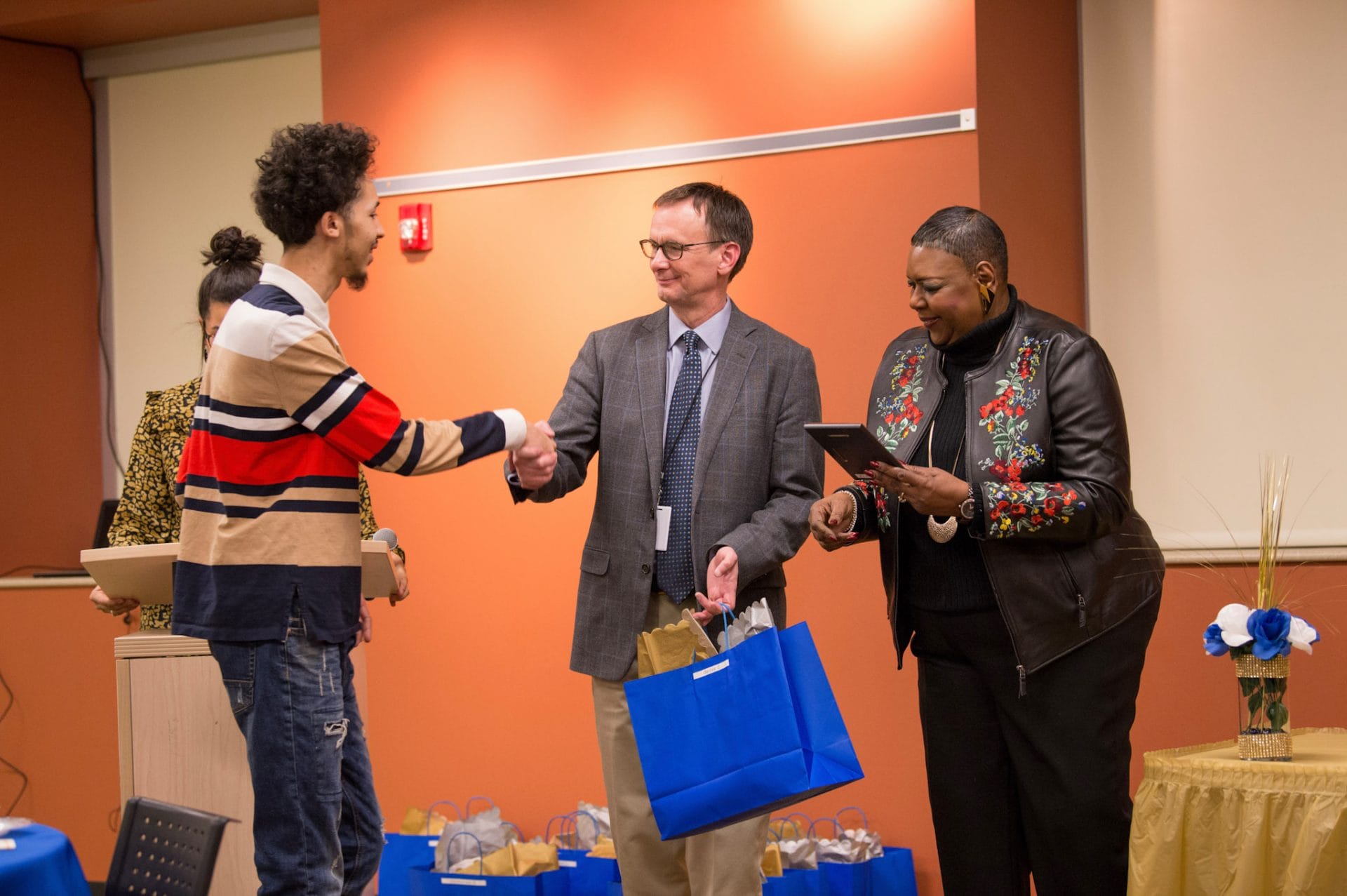
Photo taken at Pathways to New Beginnings graduation ceremony, courtesy of Urban Ventures.
Case Management
Throughout Phase I and Phase II, Pathways participants regularly meet with one of four Urban Ventures case managers, who are assigned to a specific client at the start of the process. The case manager’s role is to be a mentor and a support to the participants. In building a close and trusting relationship, case managers also identify participants’ needs and make referrals to community organizations for things like legal services and emergency housing.
Urban Ventures maintains a wide network of community partners and is able to match participants up with services to meet their individual needs. For those interested in exploring a particular career path, case managers arrange for participants to shadow local architects and lawyers, sit in on a board meeting, or whatever might help create inspiration.
Hawn, in addition to being the president and CEO of Urban Ventures, is also a case manager for Pathways participants. He underscored the broad range of support that a case manager may offer a participant, depending on the circumstances. “The role is about giving love and support,” Hawn said. “I try to be a mentor rather than just another buddy. We talk about life and that leads to all kinds of things…I’ve gone car shopping, apartment hunting, all of it, and I’ve loved it all. After doing this work for three-and-a-half years, I’ve learned that many of these guys have never had a positive male role model before.”106
That lesson and the enormous value of a mentoring relationship for Pathways participants was brought home in a powerful way for Hawn just a few months into working with his very first client, an outwardly tough young man named KJ.
“I was driving KJ one day to get something to eat, and we just really connected in our conversation,” recalled Hawn. “At some point I said to him, ‘I am so proud of you, way to go.’ Then it suddenly got quiet in the car and I heard sniffling, and KJ was wiping his eyes. He was embarrassed, so I didn’t say anything, but he finally said, ‘That’s the first time anyone has told me that they’re proud of me.’”107
KJ went on to complete the Pathways program and is still in touch with Hawn, who received messages of love and thanks from many Pathways participants and graduates on Father’s Day this year.
Graduation
Mary Ellen Heng described the first Pathways graduation as one of one of the best moments of her life. After three young men approached her to ask if she was the prosecutor and she tentatively answered in the affirmative, she was taken aback when all of them shook her hand vigorously and said “Thank you for this program; we’re so happy we did this.”108
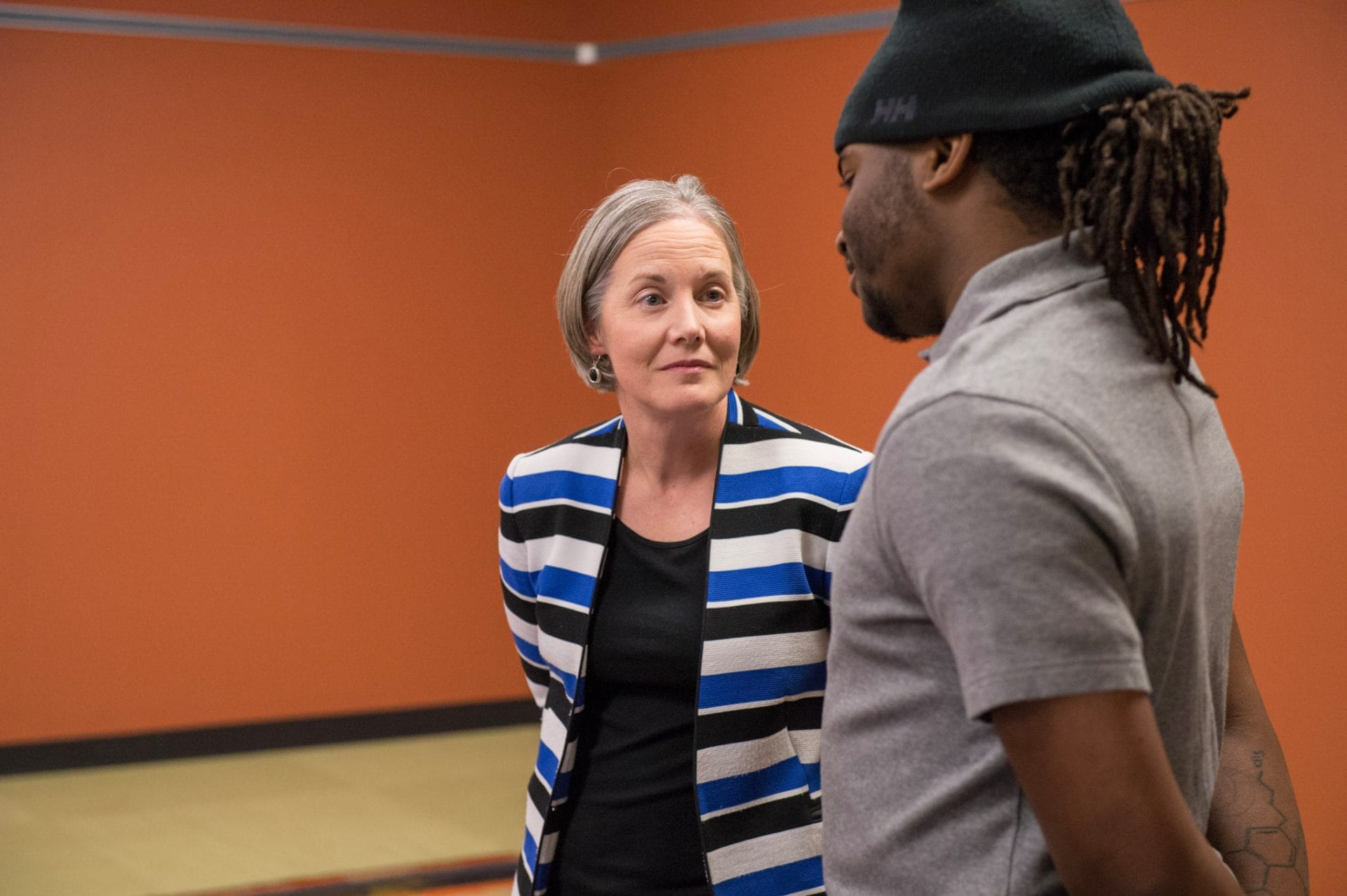
Photo taken at Pathways to New Beginnings graduation ceremony, courtesy of Urban Ventures.
She also heard from a mother of a defendant, who said she wasn’t surprised when her son was ultimately convicted of illegal possession of a gun. The mother said she figured her son would end up in jail or killed because when he was just 14 years old, he witnessed his brother’s murder firsthand.
“I couldn’t imagine what that does to a person, let alone a kid,” said Heng.109 Thanks to Pathways, this young man now faced a very different future.

At the first graduation ceremony for Pathways participants in March of 2019, family members in attendance looked on with pride as graduates were given plaques to commemorate their achievement. One graduate shared candidly with the group: “I have a career I love that I’ve worked at for 15 years. If it wasn’t for the people here, I would have thrown it all away and ruined my life. Instead, I’m getting another chance.”110
Mayor Jacob Frey emphasized that through Pathways, the City of Minneapolis was making a bet on the future of the participants, choosing to support them rather than simply incarcerate them. “Look at the people around you right now,” he said. “They are expecting great things, and there is no doubt in my mind that you will live up to every single ounce of potential that you have right here. You got it. And, I’m proud to say, we’ve got you.”111
For participants, graduation also meant holding up their end of the bargain offered by the city attorney’s office at the start of the process. In exchange, one year after graduation, participants have their cases dismissed. Bowles completed Pathways on July 4, 2020. One year later, his lawyer confirmed that his case had been dropped and that all records related to the case had been expunged.112
Bowles had no prior record, and Pathways allowed him to continue running his business and caring for his family without the interruptions of a jail sentence and the disruptive consequences of a criminal record.
Bowles was skeptical at first, given the time commitment required to complete Pathways, but by the end of the program he was thanking his lawyer for recommending this option. “When you just send someone to prison, you’re not learning the root cause of why they did what they did,” he said. “Before you sentence someone to prison, you should ask what the internal issue is: is it trauma, or mental health, or something else? Then you can get to the root cause. Most people have a reason behind doing what they were doing, and that’s why people reoffend: you didn’t give them the teachings and lessons that they needed.”113
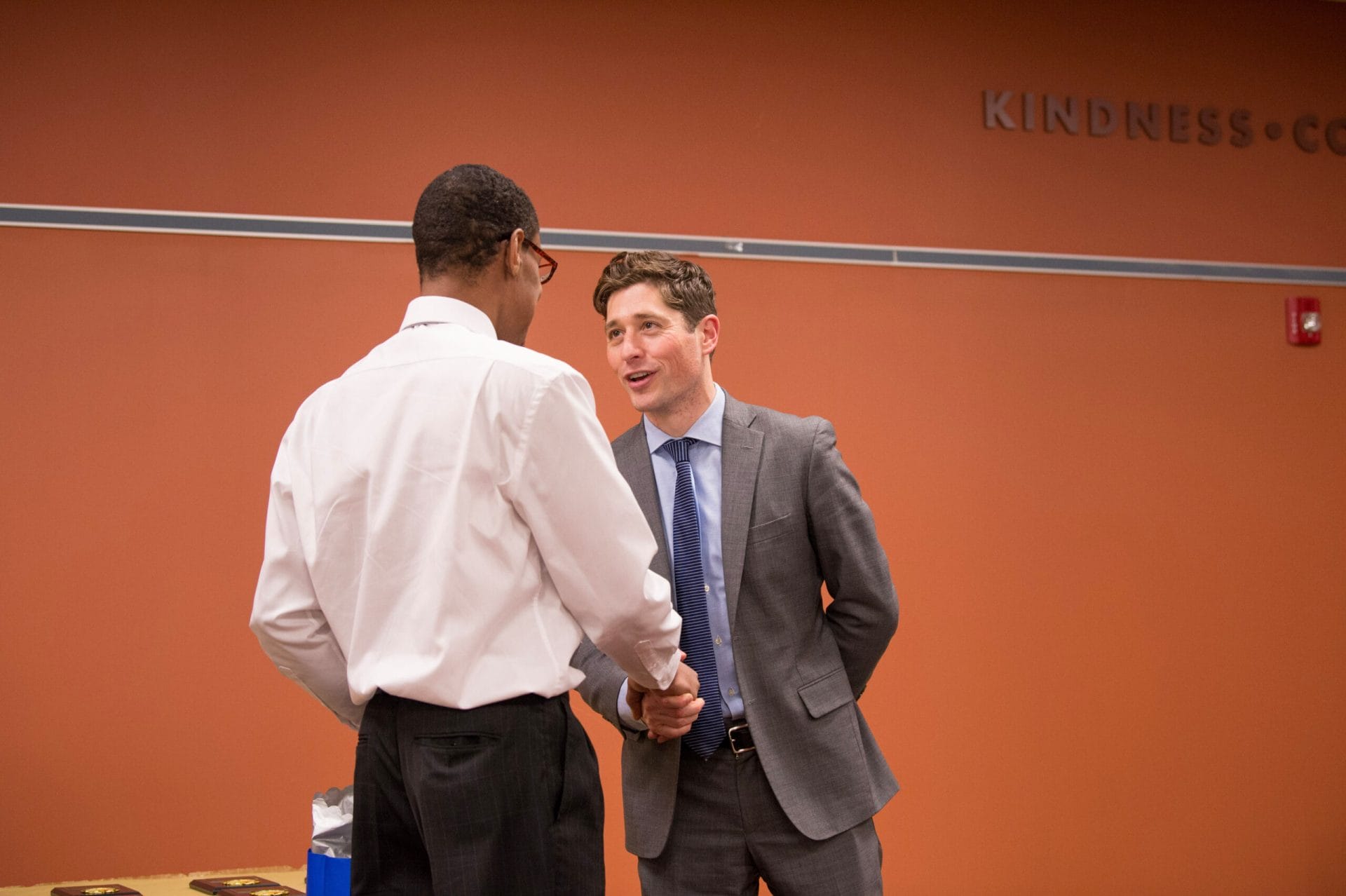
Photo taken at Pathways to New Beginnings graduation ceremony, courtesy of Urban Ventures.
Results
As of November 2021, the Minneapolis City Attorney’s Office has reviewed more than 360 gun cases to determine defendants’ eligibility for Pathways participation. Of the 214 defendants found to be eligible, 126 have agreed to participate. Fifty-nine have successfully graduated, 46 are actively advancing through the program, and 21 have dropped out or been terminated.114
Pathways participants have been graduating on a rolling basis since November of 2018. Of the 59 total graduates, the overall recidivism rate—the percentage of individuals with a subsequent conviction of a new crime—is just 10% (six new convictions). Of the new convictions, only one involved violence (misdemeanor domestic violence).115 It should be noted that some additional Pathways clients are facing new pending charges, but even assuming all of those cases result in convictions, the overall recidivism rate for the Pathways graduate population would still be 27% (16 new convictions out of 59 graduates). Of the new pending charges, only one includes an allegation of violence (felony assault).

“It has been almost three years for some of the participants and our data is still holding strong,” said Heng. “And the instances of new violent felony cases have been drastically reduced among this group.”116 Indeed, the overall recidivism rate for Pathways participants is significantly lower than the historical one-year (46%), two-year (44%), and three-year (57%) average recidivism rates for those convicted of nonviolent misdemeanor weapons charges in Minneapolis.117
The results of a rigorous statistical evaluation of Pathways by the University of Chicago are still pending, but initial data suggests that Pathways participants have lower recidivism rates compared to individuals who are convicted and given a traditional jail sentence. This is in line with the existing literature, discussed above, which suggests that diversion programs have moderate to large impacts on recidivism rates and are effective at keeping individuals out of jail.
This not only presents a public safety benefit in terms of lowered rates of crime—it also represents significant cost savings. At $192 per day to keep an individual in jail, each misdemeanor weapons offense, which carries a 30-day jail sentence, costs a baseline of $5,760 per defendant, just for incarceration costs—that doesn’t include the significant related costs of other aspects of the criminal justice system, both pre-conviction and post-release.118 Nor does it capture the negative impacts of a violent criminal record on the lives and prospects of convicted individuals.
In contrast, the per-client cost of Pathways programming is $1,617.119 “If you look at the numbers, I think Minneapolis is saving tenfold by people not recidivating as much down the line, since the cost of incarceration is so high,” said Heng.120 This is also in line with the existing literature on the cost savings of diversion programs in other contexts, where researchers have found that diversion programs are “highly successful in freeing up resources.” An NIJ analysis of four diversion programs around the country found that all produced sizable cost savings.121
Asked if he would recommend a diversion program like Pathways to others facing weapons charges, program graduate Marsell Brown didn’t hesitate. “I would 100% recommend it, one thousand times over,” said Brown. “It will help you grow mentally and make better decisions. I believe it could save your life.”122
Recommendations
As of the publication of this report, only a small handful of diversion programs exist for nonviolent gun possession. The following recommendations are intended to encourage the proliferation and evolution of these diversion programs.
Based on the current research, expanding this option would help to reduce recidivism; improve public safety; reduce the negative impact of the criminal legal system in communities of color; lower costs; and improve outcomes for individuals who, in many cases, have been the victims of structural racism, multiple forms of violence, and unaddressed trauma.
These recommendations are broken down into two sections: those for prosecutors and those for state legislators.
Prosecutors: Implement Diversion Programs for Nonviolent Gun Charges
Diversion, especially diversion for those with firearm charges, is a departure from traditional approaches in the criminal legal system and will require prosecutors to justify its use. Prosecutors should begin as Heng and her team did at the Minneapolis City Attorney’s Office and analyze recidivism data to determine the impact of the status quo approach. The numbers in Minneapolis indicated that although diversion would be a risk, because there was a considerable need for improvement in the system, it was a risk worth taking.
Make the Case for Diversion with Data
A new wave of prosecutors around the country are embracing transparency by analyzing data and making it available to the public. Prosecutors should conduct a rigorous analysis of the outcomes associated with incarceration for individuals charged with gun possession. In addition to the Minneapolis case study discussed in detail above, another example of the importance of data collection and transparency comes from a report from Fair and Just Prosecution, which describes how, after Milwaukee District Attorney John Chisholm took office in 2007:
Data is a way to keep score in an objective and useful way, but this only works if the data is made available and examined in the first place. In analyzing recidivism rates for people with firearm-related charges, more prosecutors are likely to find what Heng and her team in Minneapolis found: that convictions are being enforced in a racially skewed manner, are not putting defendants on a good path, and are not improving public safety.124
“Prosecutors have to commit themselves to performance measures like reducing incarceration, racial disparity, the rate of reoffending, and findings of misconduct,” concluded Bazelon in Charged. “They have to commit to increasing community satisfaction with local justice—and then show how they score.”125
If the data shows that the status quo isn’t working, then the next step is adopting a better alternative.
Implement a Gun Diversion Program Using Promising Practices
Each jurisdiction is unique, but there are certain promising practices that prosecutors and their partner stakeholders should keep in mind when implementing a diversion program for nonviolent gun offenses. Promising Practices in Prosecutor-Led Diversion, a report by Fair and Just Prosecution, is a useful tool for prosecutors that lists several key considerations when implementing a diversion program. These include relying on clinical staff to design programming, rigorously tracking outcome data, avoiding imposing costs on participants, and limiting exclusionary criteria that unnecessarily restrict access to diversion programming.126 Another excellent starting point is Principles of Prosecutor-Led Gun Diversion Programming from the University of Chicago. Several of these and other related recommendations are explored in more detail below.
Partner with Community-Based Organizations to Create Programming
First and foremost, diversion programming should be evidence-based, trauma-informed, and provided by experienced and qualified community-based organizations in partnership with local prosecutor offices. An NIJ study of all forms of prosecutor-led diversion found that, too often, programs are not designed based on evidence about what actually works to reduce recidivism and improve outcomes for participants.
For example, many surveyed programs ordered participants to participate in non-therapeutic classes about topics like drugs and the problems associated with drug use, while very few incorporated elements of cognitive-behavioral therapy.127 The study’s authors recommended that prosecutors establishing diversion programs consider programs with a CBT focus128
Given low levels of trust in the criminal legal system in underserved communities of color, prosecutors should partner with community-based organizations to ensure that programming is culturally competent and when possible, facilitated by individuals with lived experiences similar to those of participants. By contracting services through Urban Ventures, an established and trusted community organization, the Minneapolis City Attorney’s Office was able to connect defendants with programming provided in a third-party setting meant to encourage engagement and respond to participants’ needs.
Prosecutors implementing diversion programs should use a competitive solicitation process to encourage applications from community organizations that will design evidence-based programming with a trauma-informed lens. A variety of resources are available to help get prosecutors up to speed on evidence-based interventions for those at high risk.
Solicit Feedback and Buy-in from Key Legal System Stakeholders
Many defendants learn about diversion programs through their public defender. As prosecutors at the Minneapolis City Attorney’s Office witnessed firsthand, if public defenders don’t believe in the value of the offer being extended to their clients, then a program is unlikely to attract willing participants. Feedback from public defenders in Minneapolis led to prosecutors offering a stay of adjudication rather than requiring a guilty plea as a condition for prosecution. Once this change was made, many more defendants began participating in Pathways.129
Given the impact a guilty plea can have on an individual’s future, it’s important to structure diversion programs to maximize the likelihood of a participant leaving with a clean record. As law professors Ronald Wright and Kay Levine have argued, requiring a guilty plea is “holding the threat of a criminal sanction over the head of a diversion participant. If he fails the program, he will face sentencing immediately – he will have no opportunity to contest guilt.”130 Prosecutors looking to implement diversion programs should have upfront conversations with their public defender peers to work out an offer structure that will incentivize participation and reduce potentially harmful consequences for participants.
In addition to public defenders, prosecutors should also seek input and buy-in from other key criminal legal system partners—including judges, clerks, probation staff, and police officers—since opposition from these stakeholders can jeopardize the success of a diversion program.131
Maximize Impact by Expanding Eligibility and Accessibility
Maximizing the number of eligible participants can greatly increase the impact of a diversion program. Prosecutors should design eligibility requirements to include as many individuals as possible. Instead of relying on a broad list of automatic disqualifying factors, eligibility should be based on narrowly defined disqualifying factors (such as a recent violent felony conviction), and supplemented by an objective risk-needs assessment.
For example, some existing diversion programs automatically exclude individuals who are being charged with a gun-related crime, even if nonviolent in nature. Only a very small percentage of individuals actually use firearms to inflict violence, which is why a blanket disqualification for gun-related offenses is not justified. Such categorical exclusions should be narrowed as much as possible, and an individualized risk-needs assessment should be used to objectively determine the risk of reoffending for a given defendant.
Milwaukee County provides one of the nation’s few examples of a diversion program that uses a universal risk-informed decision-making protocol.132 Every defendant in Milwaukee County is given a court-operated screening that classifies individuals as low, medium, or high risk of reoffending. High-risk defendants are not eligible for diversion, medium-risk defendants are eligible for a more services-intensive form of diversion, and low-risk defendants are eligible for a low-intensity, pre-filing diversion program. This helps ensure that incarceration is reserved as an option for those posing immediate risks to their communities, while services and alternative options are available to lower-risk individuals at case-appropriate dosages.
Also critical to incentivizing participation is ensuring that diversion programming is free to participants, or at least as low-cost as possible. In 2016, the New York Times analyzed 225 adult diversion programs run by prosecutors in 37 states. Two-thirds of lawyers who answered a questionnaire about diversion reported that fees were a barrier for their clients.133 Given the potential benefits of division to both individuals and society, no one should be turned away from a diversion opportunity because of lack of financial resources.
Explore New Funding Sources
Although the costs are substantially less than probation or incarceration, implementing diversion programs still requires an investment of resources. In recent years, Giffords Law Center has explored various funding streams that could be leveraged to support diversion programs for those with firearm-related charges.
Local government support is a good starting point. Many local prosecutor offices are funded by city and/or county governments that can choose to support diversion programs where there is the awareness and political will. With Pathways in Minneapolis, the city attorney’s office asked for and received a relatively modest appropriation from the city council to fund a competitive solicitation for a community partner that would design and implement a diversion program.
In addition, an increasing number of states are creating grant programs to support and expand community-based violence intervention and prevention programs. In California, the state’s Violence Intervention and Prevention Program (CalVIP) will provide $200 million in funds over the next three years to “improve public health and safety by supporting effective violence reduction initiatives in communities that are disproportionately impacted by violence.”134 Given the promising evidence that diversion programs are associated with reductions in crime recidivism rates, their expansion could be funded by programs like CalVIP.
The federal government also offers a rapidly increasing number of grants that prioritize support for community-based violence intervention programs. The Biden administration has declared strong support for “proven community violence intervention (CVI) strategies for reducing gun violence through tools other than incarceration,” and this spring, the president announced historic investments in community violence reduction strategies.135 As part of this investment, five federal agencies have been directed to prioritize community violence across 26 different grant programs.
In addition, the White House launched a 16-city CVI Collaborative, where a variety of stakeholders, including prosecutors, convene regularly.136 Prosecutors in any of the CVI Collaborative locations can and should explore the role of diversion programs in strengthening and complementing other violence reduction efforts.
Even before these historic federal opportunities, creative prosecutors have been finding ways to leverage federal dollars to expand diversion programs. In 2019, St. Louis County Prosecutor Wesley Bell announced that the St. Louis County Health Department received a $1.2 million federal grant to help expand new diversion programs being run by his office.137
This funding was made available through the Bureau of Justice Assistance’s Innovative Prosecution Solutions grant—a competitive program offered yearly to help prosecutors to reduce caseloads and use data “in innovative ways that enable prosecutors’ offices to focus resources on the people and places associated with high concentrations of crime,” among other things.138 The program currently prioritizes applicants who can demonstrate that the individuals who will benefit from the requested grant reside in high-poverty areas.
Given the expanding support for violence reduction strategies other than traditional incarceration, a lack of funding should not be an impediment to the implementation of effective diversion programming for those with nonviolent firearm-related charges. Giffords Law Center is available to consult with interested parties on identifying local, state, and federal funding streams that can be used to implement and/or expand such programs.
HERE TO HELP
Interested in partnering with us to draft, enact, or implement lifesaving gun safety legislation in your community? Our attorneys provide free assistance to lawmakers, public officials, and advocates working toward solutions to the gun violence crisis.
CONTACT US
State Legislators: Support Diversion Programs and Reform Ineffective Policies
State legislators can and should incentivize the expansion of diversion programs while also critically examining laws surrounding nonviolent firearm possession offenses, including those that allow nonviolent gun possession to be classified as a “violent” offense. Reforming unfair firearm sentencing practices can help reduce mass incarceration and improve the legitimacy of the criminal legal system without compromising public safety.
Fund Diversion Programs
California

California’s Youth Reinvestment Program (YRP), established in 2018, funds a grant process to implement trauma-informed diversion programs for youth.139 Noteworthy features of YRP include a statutory definition of trauma-informed—“an approach that involves an understanding of adverse childhood experiences and responding to symptoms of chronic interpersonal trauma and traumatic stress across the lifespan of an individual”—and a requirement that at least 90% of funding be passed to community-based organizations to provide diversion services “in underserved communities with high rates of youth arrests.”140 Grantees are required to provide diversion as well as alternative-sanction programs, academic and vocational-educational services, mentoring, behavioral health services, and/or mental health services. Through YRP, California awarded $14.5M to grantees in high-need jurisdictions around the state to expand diversion services in 2020.
With the support of YRP, the nonprofit organization Community Works was able to expand its successful Restorative Community Conferencing, a pre-charge diversion program for young people that includes a restorative justice component in which participants meet with their crime victim in facilitated conversations to create a plan to address the harm done.141
An evaluation by Impact Justice found that young people were 44% less likely to get a new sustained charge within a year of completing the program than those who were processed through the juvenile legal system.142 Researchers also found significant related cost savings compared to the traditional criminal legal system approach.143
In 2020, Community Works received a $2 million grant from the state to expand this work to San Francisco, creating a regional system of pre-charge diversion with a partnership between local prosecutors and community-based organizations.144
Colorado

The Colorado state legislature created four mental health pilot programs in selected judicial districts. These programs divert individuals with mental health conditions who are charged with nonviolent misdemeanors or petty offenses away from the criminal legal system and into community treatment programs.145 A bill enacted in 2019 created a grant program specifically to fund the pilot diversion programs, allocating just under $450,000 for this purpose.146
However, Colorado’s experience illustrates the importance of making a sustained investment to support the expansion of diversion programs: just as they were gaining traction, three of the four programs lost funding in 2020 due to pandemic-related budget cuts.
“Implementation science tells us that fully implementing new programs and creating sustainable models takes three to five years,” said Elaina Shively, director of the Center for Prevention and Restorative Justice in Colorado’s 20th Judicial District, which encompasses Boulder County. “So to yank funding when we’re 18 or so months into building this up, that was just a bummer. We had actually started to get referrals and started to build up the caseload.”147 For states considering an investment in diversion pilot programs, an up-front appropriation to allow for at least three years of operation and evaluation is a best practice.
Washington

Washington State was at one point so overwhelmed responding to mental health issues that a court ruled in a class action lawsuit that the constitutional rights of those awaiting competency evaluations in Washington jails were being violated by unreasonable delays.148
As part of a multi-pronged strategy to address its impacted criminal legal system, Washington now uses a combination of state budget appropriations and court-directed settlement funds to support diversion. This has included both an $11 million investment to “support individuals with behavioral health issues arrested for misdemeanor crimes…[including] programs that divert individuals with behavioral health disorders from the criminal justice system,”149 as well as pilot diversion programs in three different counties.150
Given that prosecutor-led diversion is an emerging strategy with tremendous promise, Giffords recommends that state legislatures foster the development of such programs through budget appropriations that encourage pilot programs and robust evaluations to help build the evidence base. We recommend that this investment include:
- Sustainable, multi-year funding for diversion pilot programs that include eligibility for defendants accused of illegal gun possession
- Prioritization for programs based on levels of need, as demonstrated by disproportionately high-level rates of incarceration and violence
- A requirement that diversion services be trauma-informed, evidence-based, and provided by a community organization in partnership with the local prosecutor
- Prioritization of programs that propose to use broad eligibility requirements
- Sufficient funding for robust third-party evaluation
Finally, in addition to funding, state legislators can make changes to the criminal legal system itself that increase access to diversion. In 2020, for example, California enacted a statute, AB 3234, that gives judges discretion to place misdemeanor offenders in pretrial diversion programs, regardless of whether the prosecutor objects to it.151 Creating multiple off ramps for defendants increases the likelihood of avoiding the costly and criminogenic impacts of incarceration. Legislators should look for such opportunities within their own specific criminal codes.
Reexamine Criminal Penalties for Nonviolent Illegal Gun Possession
It is legislatures, not prosecutors, that decide default rules of the criminal legal system such as mandatory minimum sentences and whether a weapons-related offense is classified as “violent.” These policies have enormous implications for individuals and for the criminal legal system as a whole.
State leaders should critically examine the way in which weapon possession laws are being implemented. A recent study by researchers at Loyola University’s Center for Criminal Justice Research, Policy, and Practice was the first to comprehensively analyze sentencing trends for gun possession offenses in Illinois.152 This study’s findings have tremendous implications for public policy.
One key takeaway for policymakers: firearm possession is enforced much more than actual acts of violence. In Illinois, out of all arrests and convictions for firearm-related offenses over the past decade, 72% were for firearm possession, while 28% were for discharging or using a gun while committing a violent crime.153 Researchers also found that 74% of all individuals convicted of Class 4 Felony firearm possession were Black men.154
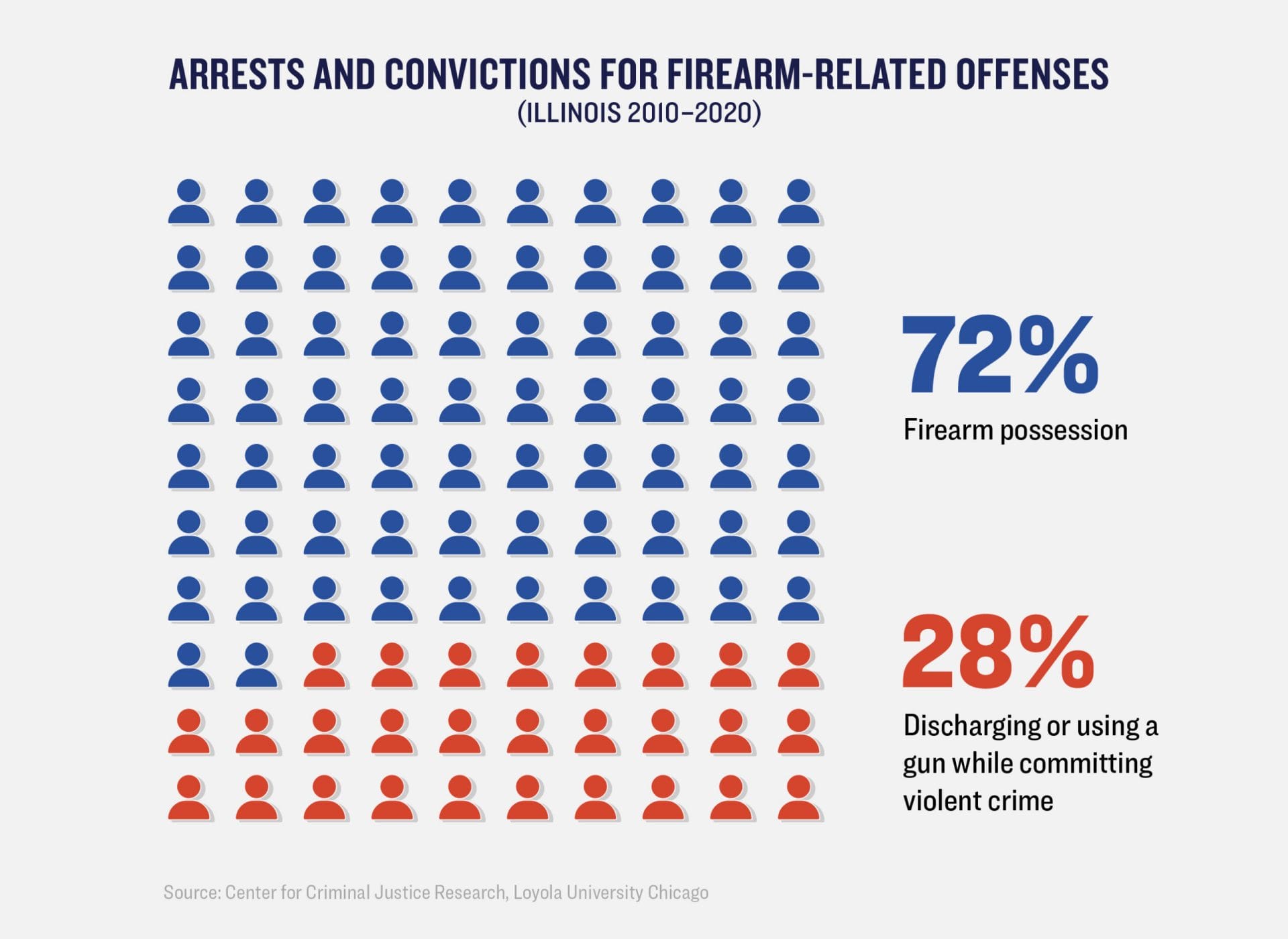
Michael Tonry, a law professor and director of the Institute on Crime and Public Policy at the University of Minnesota, studied years of research on the deterrent effects of various crime policies and found no credible evidence linking increased penalties to deterrent effects. “Policy makers would like to believe that penalties and penalty increases deter because those beliefs provide a basis for trying to do something about troubling social problems,” he wrote in a 2008 paper. “The difficulty is that mistaken beliefs in deterrence may lead to adoption of seriously mistaken policies.”155
This all underscores the need for every state to undergo a critical examination of the enforcement and sentencing practices and outcomes associated with gun-related cases. Similar patterns likely exist in other states, but hard data is needed to convince policymakers to change the status quo.
At least part of the solution lies in legislatures giving discretion back to courts in making decisions about sentencing. In California, prior to 2018, the criminal law required courts to impose a sentence enhancement of up to 25 years to life, depending on the circumstances, if the prosecutor proved that a person had a gun during the commission of a felony crime. Senate Bill 620, enacted by the California legislature and signed by the governor in 2017, gave sentencing courts the ability to strike a firearm enhancement when doing so is in the “interests of justice.”156
A California bill introduced in 2021, Assembly Bill 1509, would go even further by eliminating many of the automatic firearm-related sentence enhancements, which can lead to situations where, as proponents point out, “The enhancement is more of a punishment than the actual crime itself.”157 As the author and co-sponsors of AB 1509 describe, “reducing the use of sentencing enhancements does not mean there are no punitive actions taken, but rather, the reduction aims to curtail the extreme sentencing lengths of people who are incarcerated.”158
In addition to sentencing policy, legislators should also examine laws that allow possession of an illegal firearm to be classified as a “violent” offense. In the state of New York, for example, a conviction of criminal possession of a firearm in the second degree is a violent felony offense. Yet this crime does not require that prosecutors prove intent to use the gun—mere possession of a loaded gun in public without a permit is enough for a conviction, even for a person with no prior criminal record. Individuals convicted under this law face a minimum of three years and a maximum of fifteen in jail, and a label of “violent” felon.
The classification of a crime as “violent” has wide-ranging implications. “Anyone convicted of such offenses can face longer mandatory-minimum sentences, the triggering of ‘three-strikes-you’re-out,’ and ‘habitual violent offender’ penalties and, in immigration cases, are at risk of deportation,” wrote Eli Hager for the Marshall Project. “If those convicted of such offenses ever get rearrested, they could, at the bail hearing, be considered to have a violent criminal history—and therefore be sent to jail instead of getting released on bond or supervision.”159 The label of “violent” felon also impacts voting rights—many states only allow nonviolent offenders to restore their voting rights.
Reexamining the standards for classifying an offense as “violent” is an important aspect of addressing mass incarceration. As a report by the Prison Policy Institute points out, reducing the astronomic incarceration levels in the US “will be impossible without changing how we respond to violence because of the sheer number of people—over 40% of prison and jail populations combined—locked up for violent offenses.”160
At some point, difficult choices will have to be made about how to deal with those convicted of truly violent crimes, but an easy place to start is with situations where a person is labeled as “violent” even when the charges brought against them did not involve an act of violence. In the context of gun possession, state laws should be clear that only actual acts or attempted acts of violence may be classified as “violent” crimes.
Incentivize Local Law Enforcement to Solve Violent Crime
State leaders can help incentivize localities to embrace a necessary change in law enforcement strategy: prioritizing enforcement resources on actual acts of violence. Research from criminologist Anthony Braga found that a handful of police practice reforms put in place through the Boston Homicide Clearance Project led to a 23% increase in the homicide clearance rate.161 These improvements came both from increasing resources for the department’s homicide unit and strengthening connections to victim-assistance organizations.162
In too many cities, resource allocations don’t reflect a commitment to prioritizing acts of serious violence: in 2017, 40% of felony assault cases were not even assigned to an investigator in Oakland, California, and that same year in Portland, Oregon, 38% of felony assaults went unassigned.163 Failing to even investigate acts of violence seriously undermines public confidence in law enforcement, particularly in disproportionately impacted communities of color, and fuels cycles of retaliatory violence.164
To help reduce gun violence, states should prioritize supporting cities in efforts to improve homicide and nonfatal shooting solve rates. Given the small percentage of individuals who commit acts of violence in any given city,165 this strategy would reduce the overall incarceration footprint while significantly improving both public safety and public trust in the legitimacy and efficacy of law enforcement.
The state of New York, through its Division of Criminal Justice Services (DCJS) funded a pilot program in 2016 for two cities disproportionately impacted by gun violence.166 With a modest influx of resources and the provision of technical assistance, DCJS helped these cities develop written protocols for effectively investigating nonfatal shootings. Police departments in both cities committed to conducting thorough investigations, and local prosecutors agreed to support investigation efforts early and often.
Evaluators found that both pilot sites managed to dramatically increase solve rates for nonfatal shootings: during the three-year implementation period, the solve rate for nonfatal shootings in Utica increased from 23% to 36%,167 while in Newburgh, investigators increased solve rates from just 14% up to 40%.168 During this same period, Newburgh saw an 80% decrease in the number of shooting victims.169
Despite the common view that violent gun crimes are difficult to solve, experiences in Boston and New York show that significant improvement is possible with increased focus and additional resources to improve outcomes.
Conclusion
The United States lost 45,000 Americans to gun violence last year, a staggering increase of nearly 15% over the previous year. There are many proven ways to reduce the toll of gun violence, including funding community-based violence intervention programs. But as the evidence shows, locking up nonviolent offenders for firearm-related charges is not one of them.
For far too long, the government touted laws and the strict enforcement of them as a panacea to violent crime. This approach didn’t achieve its stated goal of reducing violent crime, and brought terrible collateral damage to communities already reeling from high homicide rates.
Today, our approach as a movement is more nuanced and more cognizant of the disproportionate impact that the enforcement of many of these laws has had on communities of color. As part of our quest as an organization and a movement to reimagine public safety and build a future free from both gun violence, we must continue to explore and invest in the promising approach explored in this report: offering diversion programs to individuals with nonviolent firearm-related charges.
Prosecutors and state legislators should follow suit by supporting diversion programs like Pathways to New Beginnings in Minneapolis, which is lowering recidivism and improving outcomes for young people who would otherwise be swept up into the criminal legal system for offenses that didn’t involve an act of violence.
To truly improve public safety, we must invest in under-resourced communities, not ravage them. We must give young men and women who have experienced trauma pathways to new beginnings, not send them into a revolving door of incarceration and violence.
Navigating a path to a better future will require marshaling significant resources and political will. We hope this report serves as a useful call to action for charting this course.
JOIN THE FIGHT
Gun violence costs our nation 40,000 lives each year. We can’t sit back as politicians fail to act tragedy after tragedy. Giffords Law Center brings the fight to save lives to communities, statehouses, and courts across the country—will you stand with us?

- Emily Bazelon, Charged: The New Movement to Transform American Prosecution and End Mass Incarceration (New York: Random House, 2019), 33.[↩]
- N.Y. Penal Law § 265.03; See also Emily Bazelon, Charged: The New Movement to Transform American Prosecution and End Mass Incarceration (New York: Random House, 2019), 59.[↩]
- N.Y. Penal Law § 70.02.3(b).[↩]
- “Youth Diversion,” The Brooklyn District Attorney’s Office, last accessed October 27, 2021, http://www.brooklynda.org/youth-diversion/.[↩]
- Emily Bazelon, Charged: The New Movement to Transform American Prosecution and End Mass Incarceration (New York: Random House, 2019), 74.[↩]
- Californians for Safety and Justice, Repairing the Road to Redemption in California, May 2018, https://safeandjust.org/wp-content/uploads/CSJ_SecondChances-ONLINE-May14.pdf.[↩]
- Emily Bazelon, Charged: The New Movement to Transform American Prosecution and End Mass Incarceration (New York: Random House, 2019), 248.[↩]
- See Emily Bazelon, “De Blasio Doesn’t Get It. Not Everyone Who Carries a Gun Is a Shooter,” New York Times, July 11, 2019, https://www.nytimes.com/2019/07/11/opinion/deblasio-guns-prison.html.[↩]
- The Brooklyn District Attorney’s Office, “Brooklyn Continued to Record Historic Decline in Violent Crime in 2019,” news release, January 3, 2020, http://brooklynda.org/2020/01/03/brooklyn-continued-to-record-historic-decline-in-violent-crime-in-2019/.[↩]
- A new report by the University of Chicago’s Smart Decarceration Project notes that eight such programs have been identified nationwide. See Smart Decarceration Project at the University of Chicago, Principles of Prosecutor-Led Gun Diversion Programming: The National Landscape and Current Trends, Fall 2021, https://cpb-us-w2.wpmucdn.com/voices.uchicago.edu/dist/2/1015/files/2017/01/SDP-PLGDP-Brief-Fall-2021-FINAL.pdf.[↩]
- Interview with Mary Ellen Heng (City Attorney’s Office of Minneapolis), October 15, 2019.[↩]
- Interview with David Hawn (Urban Ventures), July 16, 2021.[↩]
- Courts also have an important role to play, especially when prosecutors are unable or unwilling to take a diversion approach. While the focus of this report is on prosecutor-led diversion, we plan to explore other approaches, including court-led approaches, in subsequent materials.[↩]
- Michael Rempel, et al., NIJ’s Multisite Evaluation of Prosecutor-Led Diversion Programs: Strategies, Impacts, and Cost-Effectiveness, Center for Court Innovation, April 2018, https://www.ojp.gov/pdffiles1/nij/grants/251665.pdf; Richard Dembo, et al., “Evaluation of an Innovative Post-Arrest Diversion Program: 12-Month Recidivism Analysis,” Journal of Offender Rehabilitation 47, no. 4 (2008): 356-384, DOI: 10.1080/10509670801992418, https://doi.org/10.1080/10509670801992418; Anthony Petrosino, et al., “Formal System Processing of Juveniles: Effects on Delinquency,” Campbell Systematic Reviews 6, no. 1 (2010): 1-88, DOI: 10.4073/csr.2010.1, https://doi.org/10.4073/csr.2010.1; John K. Iglehart, “Decriminalizing Mental Illness—The Miami Model,” New England Journal of Medicine 2016, no. 374 (May 5, 2016): 1701-1703, DOI: 10.1056/NEJMp1602959, https://www.nejm.org/doi/full/10.1056/NEJMp1602959; See also Fair and Just Prosecution, Promising Practices in Prosecutor-Led Diversion, 2017, https://fairandjustprosecution.org/wp-content/uploads/2017/09/FJPBrief.Diversion.9.26.pdf.[↩]
- Michael Rempel, et al., NIJ’s Multisite Evaluation of Prosecutor-Led Diversion Programs: Strategies, Impacts, and Cost-Effectiveness, Center for Court Innovation, April 2018, https://nij.ojp.gov/library/publications/nijs-multisite-evaluation-prosecutor-led-diversion-programs-strategies-impacts.[↩]
- Id.[↩]
- Emily Riley, “To Charge or Not to Charge? How Prosecutors Drive Mass Incarceration,” The Crime Report, October 9, 2020, https://thecrimereport.org/2020/10/09/to-charge-or-not-to-charge-how-prosecutors-drive-mass-incarceration/.[↩]
- In some states, for example, especially in the context of misdemeanor charges, police may have the power to prosecute cases directly. See Alexandra Natapoff, “When the Police Become Prosecutors,” New York Times, December 26, 2018, https://www.nytimes.com/2018/12/26/opinion/police-prosecutors-misdemeanors.html.[↩]
- Vera Institute of Justice, People in Jail and Prison in Spring 2021, June 2021, https://www.vera.org/downloads/publications/people-in-jail-and-prison-in-spring-2021.pdf.[↩]
- National Research Council, The Growth of Incarceration in the United States: Exploring Causes and Consequences, 2014, https://www.nap.edu/catalog/18613/the-growth-of-incarceration-in-the-united-states-exploring-causes.[↩]
- The Sentencing Project, U.S. Prison Population Trends: Massive Buildup and Modest Decline, September 17, 2019, https://www.sentencingproject.org/publications/u-s-prison-population-trends-massive-buildup-and-modest-decline/.[↩]
- Emily Bazelon, Charged: The New Movement to Transform American Prosecution and End Mass Incarceration (New York: Random House, 2019), 57-59; See also James Forman Jr., “Racial Critiques of Mass Incarceration: Beyond the New Jim Crow,” New York University Law Review, no. 87 (2012): 21.[↩]
- United States Sentencing Commission, Fiscal Year 2020: Overview of Federal Criminal Cases, April 2021, https://www.ussc.gov/sites/default/files/pdf/research-and-publications/research-publications/2021/FY20_Overview_Federal_Criminal_Cases.pdf.[↩]
- “Table 29: Estimated Number of Arrests, United States, 2019,” Crime in the United States, Uniform Crime Reporting, FBI, last accessed December 2, 2021, https://ucr.fbi.gov/crime-in-the-u.s/2019/crime-in-the-u.s.-2019/tables/table-29.[↩]
- The United States Attorney’s Office, Middle District of Louisiana, “DOJ Charges More Than 14,200 Defendants with Firearms-Related Crimes in Fiscal Year 2020 – Middle District of Louisiana Charged 72 Cases,” news release, October 14, 2020, https://www.justice.gov/usao-mdla/pr/doj-charges-more-14200-defendants-firearms-related-crimes-fiscal-year-2020-middle.[↩]
- California Law Revision Commission, Committee on Revision of the Penal Code, “Memorandum 2020-11: Sentencing Enhancements: Overview,” September 10, 2020, http://www.clrc.ca.gov/CRPC/Pub/Memos/CRPC20-11.pdf.[↩]
- Id.[↩]
- Id.[↩]
- Daniel Kim, “Social determinants of health in relation to firearm-related homicides in the United States: A nationwide multilevel cross-sectional study,” PLOS Medicine 16, no. 12 (December 17, 2019), https://journals.plos.org/plosmedicine/article?id=10.1371/journal.pmed.1002978#sec016.[↩]
- Vera Institute of Justice, Accounting for Violence: How to Increase Safety and Break Our Failed Reliance on Mass Incarceration, 2017, https://www.vera.org/downloads/publications/accounting-for-violence.pdf.[↩]
- Jeremy Travis, et al., “The Growth of Incarceration in the United States: Exploring Causes and Consequences,” National Academies Press, 2014, https://academicworks.cuny.edu/cgi/viewcontent.cgi?article=1026&context=jj_pubs.[↩]
- David Roodman, “The Impacts of Incarceration on Crime,” Open Philanthropy Project, September 25, 2017, http://dx.doi.org/10.2139/ssrn.3635864; Francis T. Cullen, et al., “Prisons Do Not Reduce Recidivism: The High Cost of Ignoring Science,” The Prison Journal 91, no. 3 (2011), DOI: 10.1177/0032885511415224, https://doi.org/10.1177%2F0032885511415224.[↩]
- David E. Olson, et al., “Sentences Imposed on Those Convicted of Felony Illegal Possession of a Firearm in Illinois: Examining the Characteristics and Trends in Sentences for Illegal Possession of a Firearm,” Center for Criminal Justice Research, Policy & Practice, Loyola University Chicago, July 2021, https://www.luc.edu/media/lucedu/ccj/pdfs/firearmpossessionsentencinginillinois.pdf.[↩]
- Id.[↩]
- CDC WISQARS, Fatal Injury Reports, National, Regional and State; “Fatal Injury Data,” Web-based Injury Statistics Query and Reporting System (WISQARS), Centers for Disease Control and Prevention, 2001–2018, https://www.cdc.gov/injury/wisqars.[↩]
- Chip Mitchell, “Kim Foxx’s Office Says CPD Is Arresting The Wrong People To Curb Gun Violence,” WBEZ Chicago, June 11, 2021, https://www.wbez.org/stories/kim-foxxs-office-says-cpd-is-arresting-the-wrong-people-to-curb-gun-violence/5f78bab4-584e-4188-afc9-9dedfb0565c5.[↩]
- Thomas P. Abt, “Towards a framework for preventing community violence among youth,” Psychology, Health & Medicine 22, no. 1 (2017), https://www.tandfonline.com/doi/full/10.1080/13548506.2016.1257815; Lurie, Stephen, et al., “The Less Than 1%: Groups and the Extreme Concentration of Urban Violence,” PowerPoint Presentation, November 14, 2018, https://cdn.theatlantic.com/assets/media/files/nnsc_gmi_concentration_asc_v1.91.pdf.[↩]
- 720 IL Comp. Stat. § 5/24-1.1(e).[↩]
- Crime in the United States, 2020, Federal Bureau of Investigation, US Department of Justice, retrieved November 16, 2021, https://s3-us-gov-west-1.amazonaws.com/cg-d4b776d0-d898-4153-90c8-8336f86bdfec/CIUS/downloads/2020/offenses-known-to-le-2020.zip.[Table 26].[↩]
- Chip Mitchell, “Chicago’s Dismal Murder Solve Rate Even Worse When Victims Are Black,” NPR, October 9, 2019, https://www.npr.org/local/309/2019/10/09/768552458/chicago-s-dismal-murder-solve-rate-even-worse-when-victims-are-black.[↩]
- Giffords Law Center to Prevent Gun Violence, In Pursuit of Peace: Building Police-Community Trust to Break the Cycle of Violence, September 9, 2021, https://giffords.org/lawcenter/report/in-pursuit-of-peace-building-police-community-trust-to-break-the-cycle-of-violence/.[↩]
- TRAC Reports, Syracuse University, Federal Weapons Prosecutions Rise for Third Consecutive Year, November 29, 2017, https://trac.syr.edu/tracreports/crim/492/.[↩]
- “Fatal Injury Data,” Web-based Injury Statistics Query and Reporting System (WISQARS), Centers for Disease Control and Prevention, 2001–2018, https://www.cdc.gov/injury/wisqars.[↩]
- Humera Lodhi, et al., “Missouri must look to public health solutions for gun violence problems, experts say,” The Kansas City Star, September 21, 2021, https://www.kansascity.com/news/state/missouri/gun-violence-missouri/article248528560.html.[↩]
- See also US Deputy Attorney General to US Department of Justice Employees, “Comprehensive Strategy for Reducing Violent Crime,” Memorandum, May 26, 2021, https://www.justice.gov/dag/page/file/1397921/download.[↩]
- Prison Policy Initiative, Building exits off the highway to mass incarceration: Diversion programs explained, July 20, 2021, https://www.prisonpolicy.org/reports/diversion.html.[↩]
- Michela Lowry, et al., Prosecutor-Led Diversion: A National Survey, Center for Court Innovation, March 2019, https://www.courtinnovation.org/sites/default/files/media/document/2019/prosecutor-led_diversion.pdf.[↩]
- “Instead of confining the work of prosecutors, criminal codes add to their power. The codes delegate to prosecutors many applications of broad language that raise troubling or expensive questions,” Ronald F. Wright, “Beyond Prosecutor Elections,” Southern Methodist University Law Review 67, no. 3 (2014): 593-615, https://scholar.smu.edu/cgi/viewcontent.cgi?article=1044&context=smulr.[↩]
- Id. at 598.[↩]
- Amita Kelly, “Does It Matter That 95 Percent Of Elected Prosecutors Are White?” NPR, July 8, 2015, https://www.npr.org/sections/itsallpolitics/2015/07/08/420913118/does-it-matter-that-95-of-elected-prosecutors-are-white.[↩]
- Id.[↩]
- Emily Bazelon, Charged: The New Movement to Transform American Prosecution and End Mass Incarceration (New York: Random House, 2019), 148.[↩]
- Id.[↩]
- Michael Rempel, et al., NIJ’s Multisite Evaluation of Prosecutor-Led Diversion Programs: Strategies, Impacts, and Cost-Effectiveness, Center for Court Innovation, April 2018, https://www.ojp.gov/pdffiles1/nij/grants/251665.pdf.[↩]
- Id.[↩]
- Id.[↩]
- Michela Lowry, et al., Prosecutor-Led Diversion: A National Survey, Center for Court Innovation, March 2019, https://www.courtinnovation.org/sites/default/files/media/document/2019/prosecutor-led_diversion.pdf.[↩]
- Id.[↩]
- Douglas B. Marlowe, et al., Painting the Current Picture: A National Report on Drug Courts and Other Problem-Solving Courts in the United States, National Drug Court Institute, June 2016, https://www.ndci.org/wp-content/uploads/2016/05/Painting-the-Current-Picture-2016.pdf.[↩]
- Michael Rempel, et al., NIJ’s Multisite Evaluation of Prosecutor-Led Diversion Programs: Strategies, Impacts, and Cost-Effectiveness, Center for Court Innovation, April 2018, https://www.ojp.gov/pdffiles1/nij/grants/251665.pdf.[↩]
- Elena Schwartz, “Do Jail Diversion Programs Really Work?” The Crime Report, July 3, 2018, https://thecrimereport.org/2018/07/03/do-jail-diversion-programs-really-work/.[↩]
- Id.[↩]
- Id.[↩]
- Melissa Labriola, et al., Prosecutor-Led Pretrial Diversion: Case Studies in Eleven Jurisdictions, Center for Court Innovation, April 2018, https://www.ojp.gov/pdffiles1/nij/grants/251664.pdf.[↩]
- Michela Lowry, et al., Prosecutor-Led Diversion: A National Survey, Center for Court Innovation, March 2019, https://www.courtinnovation.org/sites/default/files/media/document/2019/prosecutor-led_diversion.pdf.[↩]
- Id.[↩]
- Id.[↩]
- Id.[↩]
- Michael Rempel, et al., NIJ’s Multisite Evaluation of Prosecutor-Led Diversion Programs: Strategies, Impacts, and Cost-Effectiveness, Center for Court Innovation, April 2018, https://www.ojp.gov/pdffiles1/nij/grants/251665.pdf.[↩]
- Id.[↩]
- Id.[↩]
- Id.[↩]
- A “gross misdemeanor” is more serious than a simple misdemeanor but still classified as a minor crime.[↩]
- Interview with Mary Ellen Heng (City Attorney’s Office of Minneapolis), January 16, 2020.[↩]
- Id.[↩]
- Id.[↩]
- “QuickFacts: Hennepin County, Minnesota,” United States Census Bureau, last accessed October 27, 2021, https://www.census.gov/quickfacts/hennepincountyminnesota.[↩]
- Interview with Mary Ellen Heng (City Attorney’s Office of Minneapolis), October 15, 2019.[↩]
- Interview with Mary Ellen Heng (City Attorney’s Office of Minneapolis), January 16, 2020.[↩]
- Interview with Mary Ellen Heng (City Attorney’s Office of Minneapolis), July 14, 2021.[↩]
- See Minneapolis City Attorney’s Office to Ways & Means Committee, “Contract amendment with Urban Ventures to provide sentencing alternatives for gross misdemeanor weapon offenses (RCA-2019-01383),” Request for Committee Action Briefing Memo, December 10, 2019, https://lims.minneapolismn.gov/RCA/5389.[↩]
- Solicitation text is on file with Giffords Law Center to Prevent Gun Violence.[↩]
- Interview with Pricilla Brown and David Hawn (Urban Ventures), January 9, 2020.[↩]
- Id.[↩]
- Id.[↩]
- Interview with Mary Ellen Heng (City Attorney’s Office of Minneapolis), January 16, 2020.[↩]
- Minn. Stat. § 624.712.5.[↩]
- Interview with Mary Ellen Heng (City Attorney’s Office of Minneapolis), January 16, 2020.[↩]
- Interview with Mary Ellen Heng (City Attorney’s Office of Minneapolis), October 15, 2019.[↩]
- Id.[↩]
- Interview with Pricilla Brown and David Hawn (Urban Ventures), January 9, 2020.[↩]
- See Substance Abuse and Mental Health Services Administration, Principles of Community-Based Behavioral Health Services for Criminal Justice Involved Individuals, 2019, https://www.samhsa.gov/resource/ebp/principles-community-based-behavioral-health-services-criminal-justice-involved.[↩]
- Interview with Pricilla Brown and David Hawn (Urban Ventures), January 9, 2020.[↩]
- Id.[↩]
- Id.[↩]
- Interview with Damaris Bowles (Pathways to New Beginnings), July 7, 2021.[↩]
- Curriculum materials provided by Urban Ventures staff and are on file with Giffords Law Center to Prevent Gun Violence.[↩]
- Interview with Damaris Bowles (Pathways to New Beginnings), July 7, 2021.[↩]
- “What is Cognitive Behavioral Therapy?” American Psychological Association, created July 2017, https://www.apa.org/ptsd-guideline/patients-and-families/cognitive-behavioral.[↩]
- See “Curriculum,” Five Stone Media, last accessed October 27, 2021, https://www.fivestonemedia.com/reentry/.[↩]
- Interview with Damaris Bowles (Pathways to New Beginnings), July 7, 2021.[↩]
- Interview with David Hawn (Urban Ventures), July 16, 2021.[↩]
- Id.[↩]
- Id.[↩]
- Id.[↩]
- Id.[↩]
- Id.[↩]
- Interview with Mary Ellen Heng (City Attorney’s Office of Minneapolis), January 16, 2020.[↩]
- Id.[↩]
- Urban Ventures, “Minneapolis Mayor Celebrates Graduates of Pilot Program,” Tumblr, March 4, 2019, https://blog.urbanventures.org/post/183225655391/minneapolis-mayor-celebrates-graduates-of-pilot.[↩]
- Id.[↩]
- Interview with Damaris Bowles (Pathways to New Beginnings), July 7, 2021.[↩]
- Id.[↩]
- Interview with Mary Ellen Heng (City Attorney’s Office of Minneapolis), November 9, 2021.[↩]
- Id.[↩]
- Id.[↩]
- Interview with Mary Ellen Heng (City Attorney’s Office of Minneapolis), July 14, 2021; Recidivism data provided by the Minneapolis City Attorney’s Office and on file with Giffords Law Center to Prevent Gun Violence.[↩]
- Id. Per-diem incarceration costs provided by the Minneapolis City Attorney’s Office and on file with Giffords Law Center to Prevent Gun Violence.[↩]
- Pathways program per-client costs provided by the Minneapolis City Attorney’s Office and on file with Giffords Law Center to Prevent Gun Violence.[↩]
- Interview with Mary Ellen Heng (City Attorney’s Office of Minneapolis), July 14, 2021.[↩]
- Michael Rempel, et al., NIJ’s Multisite Evaluation of Prosecutor-Led Diversion Programs: Strategies, Impacts, and Cost-Effectiveness, Center for Court Innovation, April 2018, https://nij.ojp.gov/library/publications/nijs-multisite-evaluation-prosecutor- led-diversion-programs-strategies-impacts.[↩]
- Interview with Marsell Brown (Pathways to New Beginnings), July 12, 2021.[↩]
- Fair and Just Prosecution, 21 Principles for the 21st Century Prosecutor, 2018, https://www.fairandjustprosecution.org/staging/wp-content/uploads/2018/12/FJP_21Principles_Interactive-w-destinations.pdf.[↩]
- Interview with Mary Ellen Heng (City Attorney’s Office of Minneapolis), July 14, 2021.[↩]
- Fair and Just Prosecution, Promising Practices in Prosecutor-Led Diversion, 2017, https://fairandjustprosecution.org/wp-content/uploads/2017/09/FJPBrief.Diversion.9.26.pdf.[↩]
- Id.[↩]
- Michael Rempel, et al., NIJ’s Multisite Evaluation of Prosecutor-Led Diversion Programs: Strategies, Impacts, and Cost-Effectiveness, Center for Court Innovation, April 2018, https://nij.ojp.gov/library/publications/nijs-multisite-evaluation-prosecutor-led-diversion-programs-strategies-impacts.[↩]
- Id.[↩]
- Interview with Mary Ellen Heng (City Attorney’s Office of Minneapolis), July 14, 2021.[↩]
- Ronald F. Wright, et al., “Models of Prosecutor-Led Diversion Programs in the United States and Beyond,” Annual Review of Criminology 4, (2021): 331-351, DOI: 10.1146/annurev-criminol-061020-022236, https://www.academia.edu/45380555/Models_of_Prosecutor_Led_Diversion_Programs_in_the_United_States_and_Beyond.[↩]
- Rebecca Rivas, “Felony diversion in St. Louis – and its discontents,” St. Louis American, January 9, 2020, http://www.stlamerican.com/news/local_news/felony-diversion-in-st-louis-and-its-discontents/article_a22448e4-3275-11ea-97b0-a3d06b95880f.html.[↩]
- Michael Rempel, et al., NIJ’s Multisite Evaluation of Prosecutor-Led Diversion Programs: Strategies, Impacts, and Cost-Effectiveness, Center for Court Innovation, April 2018, https://www.ojp.gov/pdffiles1/nij/grants/251665.pdf.[↩]
- Shaila Dewan, et al., “After a Crime, the Price of a Second Chance,” New York Times, December 12, 2016, https://www.nytimes.com/2016/12/12/us/crime-criminal-justice-reform-diversion.html.[↩]
- “California Violence Intervention and Prevention Grant Program,” California Board of State and Community Corrections, last accessed October 27, 2021, https://www.bscc.ca.gov/s_cpgpcalvipgrant/.[↩]
- The White House, “FACT SHEET: More Details on the Biden-Harris Administration’s Investments in Community Violence Interventions,” news release, April 7, 2021, https://www.whitehouse.gov/briefing-room/statements-releases/2021/04/07/fact-sheet-more-details-on-the-biden-harris-administrations-investments-in-community-violence-interventions/.[↩]
- The White House, “Fact Sheet: Biden-Harris Administration Announces Comprehensive Strategy to Prevent and Respond to Gun Crime and Ensure Public Safety,” news release, June 23, 2021, https://www.whitehouse.gov/briefing-room/statements-releases/2021/06/23/fact-sheet-biden-harris-administration-announces-comprehensive-strategy-to-prevent-and-respond-to-gun-crime-and-ensure-public-safety/.[↩]
- Joel Currier, “Federal grants to fund diversion programs at St. Louis city and county prosecutors’ offices,” St. Louis Post-Dispatch, October 18, 2019, https://www.stltoday.com/news/local/crime-and-courts/federal-grants-to-fund-diversion-programs-at-st-louis-city-and-county-prosecutors-offices/article_8f242fb9-d476-5598-b699-a48a70bccb90.html.[↩]
- US Department of Justice, BJA FY 21 Smart Prosecution – Innovative Prosecution Solutions, Solicitation, January 12, 2021, https://bja.ojp.gov/sites/g/files/xyckuh186/files/media/document/O-BJA-2021-55002.pdf.[↩]
- California State Legislature, State Assembly, Trauma-informed diversion programs for youth, AB 1454, introduced in State Assembly February 22, 2019, https://leginfo.legislature.ca.gov/faces/billHistoryClient.xhtml?bill_id=201920200AB1454.[↩]
- Id.[↩]
- Impact Justice, Restorative Community Conferencing: A study of Community Works West’s restorative justice youth diversion program in Alameda County, 2017, https://impactjustice.org/wp-content/uploads/CWW_RJreport.pdf.[↩]
- Impact Justice, Restorative Community Conferencing: A study of Community Works West’s restorative justice youth diversion program in Alameda County, 2017, https://impactjustice.org/wp-content/uploads/CWW_RJreport.pdf.[↩]
- Id.[↩]
- “Restorative justice diversion: A model for the future,” Community Works, August 21, 2020, http://communityworkswest.org/restorative-justice-diversion-a-model-for-the-future/.[↩]
- Colo. Rev. Stat. § 18-1.3-101.5 (2018).[↩]
- Colorado General Assembly, Senate, Mental Health Criminal Diversion Program, SB 19-211, introduced in Senate March 25, 2019, https://leg.colorado.gov/sites/default/files/2019a_211_signed.pdf.[↩]
- Moe Clark, “A pilot program to replace jail with mental health treatment was gaining traction last year. Then funding was cut.” Colorado Newsline, March 1, 2021, https://coloradonewsline.com/2021/03/01/a-pilot-program-to-replace-jail-with-mental-health-treatment-was-gaining-traction-last-year-then-funding-was-cut/.[↩]
- Washington State Department of Social and Health Services, Prosecutorial Diversion of Individuals with Serious Mental Illness Involved in the Criminal Justice System, September 2019, https://www.dshs.wa.gov/sites/default/files/rda/reports/research-11-250.pdf.[↩]
- Washington State Department of Social and Health Services, 2019-2021 Biennial Budget Summary for Trueblood Agreed Settlement, https://www.dshs.wa.gov/sites/default/files/BHSIA/FMHS/Trueblood/2020Trueblood/19-0555%20BHA%20Trueblood%202019-2021%20Budget.pdf.[↩]
- “Trueblood et al v. Washington State DSHS,” Washington State Department of Social and Health Services, last accessed October 27, 2021, https://www.dshs.wa.gov/bha/trueblood-et-al-v-washington-state-dshs.[↩]
- California State Legislature, State Assembly, Court Initiated Misdemeanor Diversion, AB 3234, introduced in State Assembly February 21, 2020, https://leginfo.legislature.ca.gov/faces/billNavClient.xhtml?bill_id=201920200AB3234.[↩]
- David E. Olson, et al., “Sentences Imposed on Those Convicted of Felony Illegal Possession of a Firearm in Illinois: Examining the Characteristics and Trends in Sentences for Illegal Possession of a Firearm,” Center for Criminal Justice Research, Policy & Practice, Loyola University Chicago, July 2021, https://www.luc.edu/media/lucedu/ccj/pdfs/firearmpossessionsentencinginillinois.pdf.[↩]
- Id.[↩]
- Id.[↩]
- Michael Tonry, “Learning from the Limitations of Deterrence Research,” Crime and Justice 37, no. 1 (2008): 279-311, http://faculty.washington.edu/matsueda/courses/371/Readings/Tonry%20Deterrence.pdf.[↩]
- California State Legislature, Senate, An act to amend Sections 12022.5 and 12022.53 of the Penal Code, relating to firearms, SB 620, introduced in Senate February 17, 2017, https://leginfo.legislature.ca.gov/faces/billTextClient.xhtml?bill_id=201720180SB620.[↩]
- “How AB 1509 May Help CA Inmates – A Top Appeals Lawyer Explains,” Spolin Law P.C., last accessed October 27, 2021, https://www.spolinlaw.com/california/how-ab-1509-may-help-ca-inmates/.[↩]
- Office of Assemblymember Alex Lee, “AB 1509 Anti-Racism Sentencing Reform Act Fact Sheet,” March 19, 2021, https://drive.google.com/file/d/19BuddUJgA8_CX9ay04FMPCnpw8BR1lD9/view.[↩]
- Eli Hager, “When ‘Violent Offenders’ Commit Nonviolent Crimes,” The Marshall Project, April 3, 2019, https://www.themarshallproject.org/2019/04/03/when-violent-offenders-commit-nonviolent-crimes.[↩]
- Prison Policy Initiative, Reforms without Results: Why states should stop excluding violent offenses from criminal justice reforms, April 2020, https://www.prisonpolicy.org/reports/violence.html.[↩]
- Anthony A. Braga, et al., “The Influence of Investigative Resources on Homicide Clearances,” Journal of Quantitative Criminology 35, no. 2 (June 2019): 337–64.[↩]
- Id.[↩]
- Sarah Ryley, et al., “Shoot Someone In a Major U.S. City, and Odds Are You’ll Get Away With It,” The Trace, January 24, 2019, https://www.thetrace.org/2019/01/murder-solve-rate-gun-violence-baltimore-shootings/.[↩]
- Id.[↩]
- See, e.g., Thomas P. Abt, “Towards a framework for preventing community violence among youth,” Psychology, Health & Medicine 22, no. 1 (2017), https://www.tandfonline.com/doi/full/10.1080/13548506.2016.1257815; “Oakland’s problem analysis…showed that only 400 individuals—just 0.1% of Oakland’s total population—were at the highest risk for engaging in serious violence at any given time,” Giffords Law Center to Prevent Gun Violence, A Case Study in Hope: Lessons from Oakland’s Remarkable Reduction in Gun Violence, April 23, 2019, https://giffords.org/lawcenter/report/a-case-study-in-hope-lessons-from-oaklands-remarkable-reduction-in-gun-violence.[↩]
- New York State, Division of Criminal Justice Services, Non-fatal Shooting Incidents Project: Research Brief, October 2020, https://knowledgebank.criminaljustice.ny.gov/system/files/documents/2020/10/non-fatal-shooting-incidents-project-research-brief_1.pdf.[↩]
- Id.[↩]
- Orange County Government Center, “District Attorney Hoovler and City of Newburgh Police Chief Amthor Announce Analysis of Non-Fatal Shootings Grant,” news release, November 12, 2020, https://www.orangecountygov.com/CivicAlerts.aspx?AID=1143.[↩]
- Lana Bellamy, “Violent crime drops significantly in City of Newburgh,” Times Herald-Record, May 9, 2019, https://www.recordonline.com/news/20190509/violent-crime-drops-significantly-in-city-of-newburgh.[↩]
